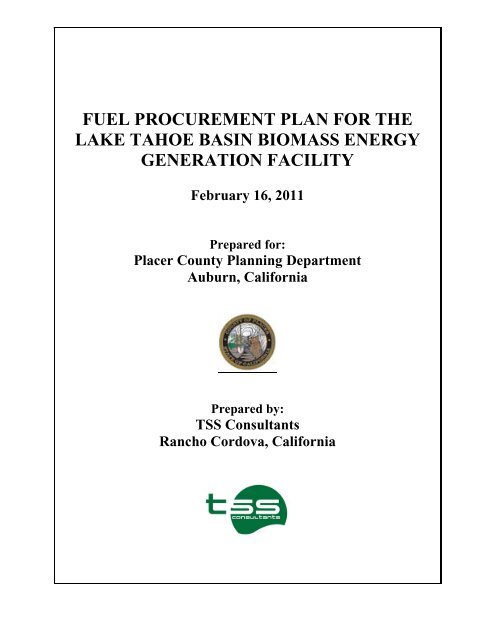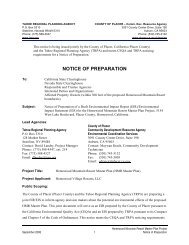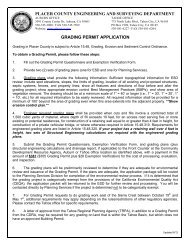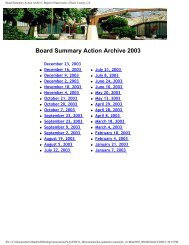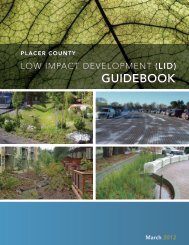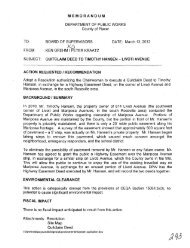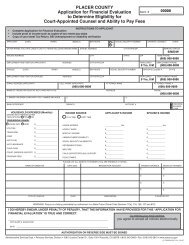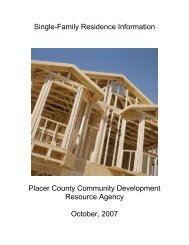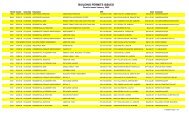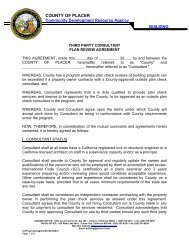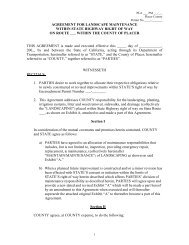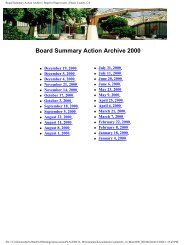Fuel Procurement Plan for the Lake Tahoe Basin - Placer County ...
Fuel Procurement Plan for the Lake Tahoe Basin - Placer County ...
Fuel Procurement Plan for the Lake Tahoe Basin - Placer County ...
- No tags were found...
You also want an ePaper? Increase the reach of your titles
YUMPU automatically turns print PDFs into web optimized ePapers that Google loves.
FUEL PROCUREMENT PLAN FOR THELAKE TAHOE BASIN BIOMASS ENERGYGENERATION FACILITYFebruary 16, 2011Prepared <strong>for</strong>:<strong>Placer</strong> <strong>County</strong> <strong>Plan</strong>ning DepartmentAuburn, Cali<strong>for</strong>niaPrepared by:TSS ConsultantsRancho Cordova, Cali<strong>for</strong>nia
TABLE OF CONTENTSEXECUTIVE SUMMARY .............................................................................................. 1ABBREVIATIONS ........................................................................................................... 2GLOSSARY OF TERMS ................................................................................................. 2LAKE TAHOE BASIN BIOMASS ENERGY PROJECT OVERVIEW .................... 4BIOMASS FUEL PROCUREMENT PLAN .................................................................. 5CORE FUEL SUPPLY AREA ........................................................................................ 5WOOD FUEL SOURCES ................................................................................................ 6Forest-Sourced <strong>Fuel</strong>s ................................................................................................................ 7Hazardous Forest <strong>Fuel</strong>s Removal in <strong>the</strong> <strong>Lake</strong> <strong>Tahoe</strong> <strong>Basin</strong> Region ................................... 7Hazardous Forest <strong>Fuel</strong>s Removal Outside <strong>the</strong> <strong>Lake</strong> <strong>Tahoe</strong> <strong>Basin</strong> Region ....................... 13Forest Thinning and Harvest Residuals ............................................................................. 14Urban-Sourced <strong>Fuel</strong>s .............................................................................................................. 16Tree Trimmings .................................................................................................................... 16Construction and Demolition Wood .................................................................................... 16WOOD FUEL SUPPLY ESTIMATES ......................................................................... 17WOOD FUEL COMPETITION ................................................................................... 18Biomass Power Generation Facilities .................................................................................... 18Operating Biomass Power <strong>Plan</strong>ts ........................................................................................ 18Idle Biomass Power <strong>Plan</strong>ts .................................................................................................. 18O<strong>the</strong>r Value-Added Uses ........................................................................................................ 20WOOD FUEL AVAILABILITY ................................................................................... 21WOOD FUEL CHARACTERIZATION ...................................................................... 22WOOD FUEL PRICING ............................................................................................... 23OPTIMIZED FUEL BLEND AND PRICING ............................................................. 24FUTURE FUEL SUPPLY SOURCES AND RISKS ................................................... 25Future Forest-Sourced <strong>Fuel</strong>s .................................................................................................. 26Future Urban-Sourced <strong>Fuel</strong>s ................................................................................................. 26Future Supply Risks ................................................................................................................ 26FUEL PROCUREMENT ............................................................................................... 27<strong>Fuel</strong> Processing Infrastructure .............................................................................................. 27Forest-Sourced <strong>Fuel</strong> Processing Infrastructure ................................................................. 27Urban-Sourced <strong>Fuel</strong> Processing Infrastructure ................................................................. 28Ranking Top Tier Suppliers ................................................................................................... 28Contracting For <strong>Fuel</strong> .............................................................................................................. 28<strong>Fuel</strong> <strong>Procurement</strong> Agreements .............................................................................................. 29<strong>Fuel</strong> <strong>Procurement</strong> Organization ............................................................................................ 30<strong>Procurement</strong> <strong>Plan</strong> Implementation Task List/Timeline ...................................................... 30OBSERVATIONS ........................................................................................................... 31<strong>Fuel</strong> <strong>Procurement</strong> <strong>Plan</strong> <strong>for</strong> <strong>the</strong> <strong>Lake</strong> <strong>Tahoe</strong> <strong>Basin</strong> Biomass Energy FacilityTSS Consultantsi
APPENDICESAPPENDIX A – Sierra Pacific Industries Press Release ............................................ 33APPENDIX B - Bio Energy News Article – NNCC Closure ....................................... 34APPENDIX C - Urban Wood and Forest <strong>Fuel</strong> Specifications .................................... 35APPENDIX D - Letter of Intent Template ................................................................... 39APPENDIX E - <strong>Fuel</strong> <strong>Procurement</strong> Manager Job Description ................................... 40LIST OF TABLESTable 1. 2010-2014 Draft Forecast of <strong>Fuel</strong>s Treatment Activities in <strong>the</strong> LTB ................ 12Table 2. Historic Timber Harvest Levels by <strong>County</strong> Within <strong>the</strong> CFSA (2005-2009) ..... 15Table 3. Forest-Sourced Biomass <strong>Fuel</strong> Practically Available Within <strong>the</strong> CFSA ............ 15Table 4. Urban-Sourced Biomass Material Practically Available Within <strong>the</strong> CFSA ...... 16Table 5. Practically Available Biomass <strong>Fuel</strong> by Type Within <strong>the</strong> CFSA ........................ 17Table 6. Biomass Power <strong>Plan</strong>ts Currently Sourcing <strong>Fuel</strong> from <strong>the</strong> CFSA ...................... 19Table 7. Current Markets <strong>for</strong> Woody Biomass Material ................................................. 21Table 8. Biomass Availability and Usage <strong>for</strong> Material Generated Within <strong>the</strong> CFSA ..... 22Table 9. Wood <strong>Fuel</strong> Characteristics by Specific <strong>Fuel</strong> Type ............................................ 23Table 10. Wood <strong>Fuel</strong> Pricing Within <strong>the</strong> CFSA .............................................................. 23Table 11. Optimized <strong>Fuel</strong> Blend ...................................................................................... 24Table 12. Task List Timeline <strong>for</strong> <strong>Fuel</strong> <strong>Procurement</strong> Activities ....................................... 31LIST OF FIGURESFigure 1. <strong>Lake</strong> <strong>Tahoe</strong> <strong>Basin</strong> Biomass Energy Project Core <strong>Fuel</strong> Supply Area ................. 6Figure 2. Recent Wildfire History (2000-2009) in <strong>the</strong> <strong>Lake</strong> <strong>Tahoe</strong> <strong>Basin</strong> ........................ 8Figure 3. Fire Regime Condition Class Map <strong>for</strong> <strong>the</strong> LTBBE CFSA ................................. 9Figure 4. <strong>Lake</strong> <strong>Tahoe</strong> <strong>Basin</strong> Fire Management Agencies ................................................ 10Figure 5. Practically Available <strong>Fuel</strong> Type by Percent of Total ....................................... 17Figure 6. Location of Biomass Power <strong>Plan</strong>ts ................................................................... 20Figure 7. <strong>Fuel</strong> Blend by Percent of Total ......................................................................... 25<strong>Fuel</strong> <strong>Procurement</strong> <strong>Plan</strong> <strong>for</strong> <strong>the</strong> <strong>Lake</strong> <strong>Tahoe</strong> <strong>Basin</strong> Biomass Energy FacilityTSS Consultantsii
EXECUTIVE SUMMARY<strong>Placer</strong> <strong>County</strong> has retained TSS Consultants (TSS) to complete a fuel availabilityassessment and develop a fuel procurement plan <strong>for</strong> <strong>the</strong> <strong>Lake</strong> <strong>Tahoe</strong> <strong>Basin</strong> BiomassEnergy (LTBBE) facility project. This fuel assessment and procurement plan isconsistent with task 7.0 of <strong>the</strong> U.S. Department of Energy (DOE) award No. DE-FG36-08GO88026. Additional investigation of long-term sustainable supply obtainable via<strong>for</strong>est stewardship contracts and o<strong>the</strong>r viable contracting opportunities was conducted toassist in determining if successful deployment of a one to three megawatt (MW) woodybiomass-to-energy facility in <strong>the</strong> Kings Beach area of <strong>Lake</strong> <strong>Tahoe</strong> can be accomplished.Such a facility would benefit hazardous <strong>for</strong>est fuels reduction programs in <strong>the</strong> <strong>Lake</strong><strong>Tahoe</strong> <strong>Basin</strong> (LTB) and is consistent with <strong>Placer</strong> <strong>County</strong>’s Strategic <strong>Plan</strong> <strong>for</strong> WildfireProtection and Biomass Utilization.The LTBBE facility will also provide a ready alternative to <strong>the</strong> current preferred disposalmethod of piling and burning material removed as a byproduct of hazardous fuelstreatment activities. The net reduction in air emissions (e.g., particulate matter, CO,NOx, SOx) by diverting this material into a controlled combustion system equipped withmaximum achievable control technology will be significant. As fire districts, landmanagement agencies and local residents ramp up fuels treatment activities (as planned),it is anticipated that significant volumes of biomass material will be generated as abyproduct.From June through August 2010, TSS conducted a comprehensive review of biomassmarkets, resource availability and current demand <strong>for</strong> biomass feedstocks in <strong>the</strong> greater<strong>Lake</strong> <strong>Tahoe</strong> region. This fuel assessment utilized a 40-year planning horizon, as this is<strong>the</strong> projected service life of <strong>the</strong> LTBBE facility. Only strategic, sustainable fuelresources consistent with <strong>the</strong> project objectives and compliant with state (Cali<strong>for</strong>niaEnvironmental Quality Act, State of Nevada Title 47 Regulations), regional (<strong>Tahoe</strong>Regional <strong>Plan</strong>ning Agency rules and guidelines), and federal (National EnvironmentalPolicy Act) regulations were considered as potentially available fuel.Results of this fuel assessment concur that <strong>the</strong>re is more than sufficient biomass materialavailable to sustain a one to three MW biomass power generation facility sited at KingsBeach, Cali<strong>for</strong>nia. TSS found that <strong>the</strong>re is approximately 112,440 bone dry tons (BDT)per year of biomass fuel practically available within a 30-mile radius of Kings Beach.Current demand amounts to about 40,350 BDT per year resulting in a net availability of72,090 BDT per year.Assuming that <strong>the</strong> LTBBE is scaled at two MW of electrical output and utilizes 20,000BDT of biomass fuel annually, <strong>the</strong>n a 3.6:1 fuel cover ratio exists. <strong>Fuel</strong> coverage ratiorepresents <strong>the</strong> net availability of fuel relative to new demand in <strong>the</strong> marketplace. Thehigher <strong>the</strong> fuel coverage ratio, <strong>the</strong> more fuel is <strong>for</strong>ecast to be available. Private financialmarkets and project developers prefer a fuel coverage ratio of 2:1 or more <strong>for</strong> newbioenergy projects.<strong>Fuel</strong> <strong>Procurement</strong> <strong>Plan</strong> <strong>for</strong> <strong>the</strong> <strong>Lake</strong> <strong>Tahoe</strong> <strong>Basin</strong> Biomass Energy Facility 1TSS Consultants
This fuel assessment confirmed that <strong>the</strong> LTBBE facility (scaled at two MW) could besustainably supplied with biomass fuel sourced from within a 20-mile radius of KingsBeach. With a 20-mile radius fuel sourcing area, over 80% of <strong>the</strong> fuel could be providedby fuels treatment activities within <strong>the</strong> LTB and <strong>the</strong> balance (20%) provided by treetrimmings and pine needles from <strong>the</strong> Eastern Regional Landfill and transfer station atTruckee. Most of this material would not be available economically to o<strong>the</strong>r markets orbiomass power plants, as transport costs are very significant and <strong>Placer</strong> <strong>County</strong> isworking with land management agencies to cost share <strong>the</strong> collection, processing andtransport expenses <strong>for</strong> biomass material that is currently open pile burned or masticated(chipped and scattered).An optimized fuel blend <strong>for</strong> this facility assumes that 75% of <strong>the</strong> facility’s fuel usage willbe sourced from hazardous fuels treatment activities, with <strong>the</strong> balance being made up of<strong>for</strong>est thinning residuals and urban-sourced (primarily tree trimmings and pine needles)wood. While urban-sourced wood represents <strong>the</strong> most cost effective fuel, utilizing largevolumes of urban wood fuel would defeat <strong>the</strong> primary objective of <strong>the</strong> LTBBE project –which is to provide a ready, sustainable market <strong>for</strong> biomass fuel generated as a byproductof hazardous fuels reduction activities.ABBREVIATIONSASTMBDTBtuCFSACWPPGTIRSCLTBLTBBELTBMUMBFMWRPSUSFSWUIAmerican Society <strong>for</strong> Testing and MaterialsBone Dry Ton(s)British Thermal UnitCore <strong>Fuel</strong> Supply AreaCommunity Wildfire Protection <strong>Plan</strong>Green Ton(s)Integrated Resource Service Contract<strong>Lake</strong> <strong>Tahoe</strong> <strong>Basin</strong><strong>Lake</strong> <strong>Tahoe</strong> <strong>Basin</strong> Biomass Energy Facility<strong>Lake</strong> <strong>Tahoe</strong> <strong>Basin</strong> Management UnitOne thousand board feetMegawatt (1,000 kW of electrical power)Renewable Portfolio StandardUSDA Forest ServiceWildland Urban InterfaceGLOSSARY OF TERMSListed below are terms that are utilized in this plan. Definitions presented here are from avariety of sources including <strong>the</strong> USDA Forest Products Lab and <strong>the</strong> Society of AmericanForesters – Forestry Dictionary.<strong>Fuel</strong> <strong>Procurement</strong> <strong>Plan</strong> <strong>for</strong> <strong>the</strong> <strong>Lake</strong> <strong>Tahoe</strong> <strong>Basin</strong> Biomass Energy Facility 2TSS Consultants
Biomass – Organic matter in trees, agricultural crops and o<strong>the</strong>r living plant material.Carbohydrates are <strong>the</strong> organic compounds that make up biomass. These compounds are<strong>for</strong>med in growing plant life through photosyn<strong>the</strong>sis, a natural process by which energyfrom <strong>the</strong> sun converts carbon dioxide and water into carbohydrates, including sugars,starches and cellulose.Board Foot – The amount of wood contained in an unfinished board 1 inch thick, 12inches long, and 12 inches wide (abbreviated “BF”). Common units as related to saw logvolume measurement include 1,000 BF or MBF and 1,000,000 BF or MMBF.Bone Dry Ton – Traditional unit of measure used by industries (pulp/paper, biomasspower) that utilize biomass as a primary raw material. One bone dry ton (BDT) is 2,000pounds of biomass (usually in chip <strong>for</strong>m) at zero percent moisture. Typically biomasscollected and processed in <strong>the</strong> <strong>for</strong>est is delivered “green” to <strong>the</strong> end use facility at 50%moisture. One BDT (assuming 50% moisture content) is two green tons (4,000 pounds at50% moisture content).British Thermal Unit – The quantity of heat required to raise <strong>the</strong> temperature of onepound of water from 60 degrees F (Fahrenheit) to 61 degrees F at a constant pressure ofone atmosphere.Chip – A small piece of wood typically used in <strong>the</strong> manufacture of pulp/paper, compositepanels, fuel <strong>for</strong> power/heat generation, and landscape cover/soil amendment.Cogeneration – The combined generation of both heat and power at one facility using<strong>the</strong> same fuel source.Ecosystem Services – The processes by which <strong>the</strong> environment produces resources thatinclude clean water, timber, recreation, and wildlife habitat.Generation – The process of creating electricity. Typically generation is accomplishedto supply electricity to an on-site facility and/or <strong>for</strong> sale to an electric utility.Green Ton – Traditional unit of measure used by industries (pulp/paper, biomass power)that utilize biomass as a primary raw material. One green ton (GT) is 2,000 pounds ofbiomass (usually in chip <strong>for</strong>m) with no correction <strong>for</strong> moisture content.Hazardous Forest <strong>Fuel</strong>s – Woody biomass material that poses a substantial fire threat tohuman or environmental health.Kilowatt – A standard unit <strong>for</strong> expressing <strong>the</strong> rate of electrical output.Megawatt – One thousand kilowatts. Enough electricity to support approximately 750 to1,000 households.<strong>Fuel</strong> <strong>Procurement</strong> <strong>Plan</strong> <strong>for</strong> <strong>the</strong> <strong>Lake</strong> <strong>Tahoe</strong> <strong>Basin</strong> Biomass Energy Facility 3TSS Consultants
Moisture content – The amount of moisture contained in biomass material. Typicallyexpressed as a percentage of total weight.Sawlog – A log that meets minimum regional standards of diameter, length, and defect,intended <strong>for</strong> sawing into lumber products.Urban Wood – Wood waste generated as a result of tree trimming, yard clean up (e.g.,pine needles, brush), pallets, clean construction and demolition wood (paint free).Typically transported and disposed of at transfer stations, this wood is separated by hand<strong>for</strong> processing into fuel quality material.LAKE TAHOE BASIN BIOMASS ENERGY PROJECTOVERVIEW<strong>Placer</strong> <strong>County</strong>, in cooperation with Cali<strong>for</strong>nia Pacific Electric Company, is in <strong>the</strong> processof developing a one to three MW biomass energy facility at Kings Beach, Cali<strong>for</strong>nia.The project is strategically located to economically utilize woody biomass materialgenerated as a byproduct of hazardous <strong>for</strong>est fuels reduction activities conducted within<strong>the</strong> <strong>Lake</strong> <strong>Tahoe</strong> region. Locating <strong>the</strong> LTBBE facility near <strong>for</strong>est landscapes targeted <strong>for</strong>fuels reduction activities mitigates costs associated with transport of biomass material.Transportation costs are a very significant barrier to utilization of biomass material that istypically open burned in place or chipped and left on site. Air emissions associated withtransport activities (diesel fumes) and open burning of hazardous fuels are also mitigated.There are a number of benefits associated with implementation of <strong>the</strong> LTBBE project,most of which are summarized in <strong>the</strong> project objectives outlined below.• Construct and operate a small-scale, sustainable, and low-impact biomass power plantin <strong>the</strong> LTB;• Improve regional air quality and reduce greenhouse gas emissions associated withopen burning of biomass material;• Improve <strong>the</strong> water quality of <strong>Lake</strong> <strong>Tahoe</strong> by reducing deposition of particulate matterassociated with open burning of biomass material;• Support healthy <strong>for</strong>est management practices that improve watershed health andwildlife habitat through planned <strong>for</strong>est thinning operations designed to reducecatastrophic wildfire risks in <strong>the</strong> LTB;• Contribute to Cali<strong>for</strong>nia’s renewable energy production goals through <strong>the</strong> operation ofa woody biomass power plant that provides a long-term renewable electrical supply to<strong>the</strong> LTB and reduces dependency on fossil fuels used to generate electricity <strong>for</strong> localconsumption;<strong>Fuel</strong> <strong>Procurement</strong> <strong>Plan</strong> <strong>for</strong> <strong>the</strong> <strong>Lake</strong> <strong>Tahoe</strong> <strong>Basin</strong> Biomass Energy Facility 4TSS Consultants
• Provide a local source of reliable, consistent power to minimize electricity disruptionsand use of existing emergency back-up diesel fuel-fired generation;• Demonstrate <strong>the</strong> use of waste heat from electricity production to heat on-site buildingsand melt snow and ice on sidewalks, parking lots, and roadways;• Create <strong>the</strong> potential <strong>for</strong> future export of waste heat energy to proposed projects and <strong>for</strong>community benefit in <strong>the</strong> North <strong>Lake</strong> <strong>Tahoe</strong> area;• Reduce transportation costs and related air pollution associated with <strong>the</strong> currentpractice of transporting woody biomass out of <strong>the</strong> LTB to distant utilization facilitiesand/or disposal sites;• Demonstrate <strong>the</strong> Public Private Partnership model that includes partnerships betweenlocal, state, and federal agencies and local businesses <strong>for</strong> renewable energydevelopment and <strong>for</strong>est health initiatives;• Provide new employment opportunities to <strong>the</strong> residents of <strong>the</strong> LTB and surroundingareas; and• Utilize existing appropriately zoned land <strong>for</strong> enhancement of public power supplywhile minimizing impacts to commercial, residential, recreational, and open-spaceuses.BIOMASS FUEL PROCUREMENT PLANThis procurement plan provides a detailed analysis of <strong>the</strong> sustainable availability ofwoody biomass fuel resources within <strong>the</strong> LTBBE Core <strong>Fuel</strong> Supply Area (CFSA).Specifically, this plan seeks to complement <strong>the</strong> unique location of <strong>the</strong> LTBBE, identifystrategic fuel resources consistent with <strong>the</strong> project objectives, and comply with state(Cali<strong>for</strong>nia Environmental Quality Act, State of Nevada Title 47 Regulations), regional(<strong>Tahoe</strong> Regional <strong>Plan</strong>ning Agency rules and guidelines), and federal (NationalEnvironmental Policy Act) regulations while confirming sustainable fuel supply.Biomass fuel availability estimates included in this plan utilize a 40-year planninghorizon that is consistent with <strong>the</strong> expected service life of <strong>the</strong> LTBBE facility. Inaddition, this plan provides relevant in<strong>for</strong>mation to <strong>the</strong> LTBBE development team, as itsets <strong>the</strong> appropriate project scale and selects <strong>the</strong> optimal biomass energy conversiontechnology considering local fuel resources.CORE FUEL SUPPLY AREABased on TSS’ experience in Cali<strong>for</strong>nia, <strong>the</strong> CFSA <strong>for</strong> commercial-scale biomass firedpower generation facilities is typically located within a 50-mile radius of <strong>the</strong> facility.Due to <strong>the</strong> relatively small scale (one to three MW) of <strong>the</strong> LTBBE facility, a 30-mile<strong>Fuel</strong> <strong>Procurement</strong> <strong>Plan</strong> <strong>for</strong> <strong>the</strong> <strong>Lake</strong> <strong>Tahoe</strong> <strong>Basin</strong> Biomass Energy Facility 5TSS Consultants
adius CFSA was utilized. Figure 1 highlights <strong>the</strong> CFSA (red line) as well as a one-hourdrive time projection <strong>for</strong> transport of biomass fuel (blue line).Figure 1. <strong>Lake</strong> <strong>Tahoe</strong> <strong>Basin</strong> Biomass Energy Project Core <strong>Fuel</strong> Supply AreaWOOD FUEL SOURCESThe CFSA highlighted in Figure 1 is a heavily <strong>for</strong>ested region that includes <strong>the</strong> SierraNevada Mountains and <strong>the</strong> LTB. It is anticipated that up to 75% of <strong>the</strong> biomass fuelprocured <strong>for</strong> <strong>the</strong> LTBBE will be <strong>for</strong>est-sourced material generated as a byproduct fromhazardous <strong>for</strong>est fuels treatments and <strong>for</strong>est thinning activities.In addition, <strong>the</strong>re is wood waste from tree trimming and yard clean up (pine needles) aswell as construction/demolition wood from building/remodeling activities. Known asurban-sourced material (to differentiate it from <strong>for</strong>est-sourced material), this fuel type isan expanding fuel source as communities seek to divert this material away fromtraditional disposal options such as landfills. Transfer stations in <strong>the</strong> LTB region (e.g.,Eastern Regional Sanitary Landfill and transfer station at Truckee) are unique in that tree<strong>Fuel</strong> <strong>Procurement</strong> <strong>Plan</strong> <strong>for</strong> <strong>the</strong> <strong>Lake</strong> <strong>Tahoe</strong> <strong>Basin</strong> Biomass Energy Facility 6TSS Consultants
trimmings comprise a significant portion (40%) of <strong>the</strong> wood waste received. 1trimmings and pine needles are a major opportunity fuel <strong>for</strong> <strong>the</strong> LTBBE.Two primary fuel types were considered in this plan including:Tree• Forest-sourced fuelso Hazardous fuels residualso Forest thinning and harvest residuals• Urban-sourced fuelso Tree trimmings and pine needleso Clean construction and demolition woodForest-Sourced <strong>Fuel</strong>sHazardous Forest <strong>Fuel</strong>s Removal in <strong>the</strong> <strong>Lake</strong> <strong>Tahoe</strong> <strong>Basin</strong> RegionA major consequence of wildfire suppression ef<strong>for</strong>ts of <strong>the</strong> past century has been asignificant buildup of <strong>for</strong>est fuels. This unnatural accumulation of hazardous fuelsrepresents a serious threat to <strong>for</strong>est ecosystems and communities. During <strong>the</strong> past 10years, <strong>the</strong> LTB has experienced wildfire events on approximately 4,500 acres. Due to <strong>the</strong>fact that much of <strong>the</strong> LTB is accessible by road and that fire response infrastructure iswell equipped and highly organized, most wildfires have not exceeded 100 acres in size.However, <strong>the</strong> Angora Fire of 2007 was an exception, consuming 3,100 acres and 254homes over <strong>the</strong> span of 48 hours and is an indication of <strong>the</strong> wildfire threat that exists in<strong>the</strong> LTB. Figure 2 is a fire history map showing <strong>the</strong> location of wildfires (over 20 acresin size) within <strong>the</strong> LTB in <strong>the</strong> last decade.1 Per discussions with Chris Donica, Operations Manager, East Regional Sanitary Landfill.<strong>Fuel</strong> <strong>Procurement</strong> <strong>Plan</strong> <strong>for</strong> <strong>the</strong> <strong>Lake</strong> <strong>Tahoe</strong> <strong>Basin</strong> Biomass Energy Facility 7TSS Consultants
Figure 2. Recent Wildfire History (2000-2009) in <strong>the</strong> <strong>Lake</strong> <strong>Tahoe</strong> <strong>Basin</strong>Map is provided courtesy of <strong>the</strong> Cali<strong>for</strong>nia <strong>Tahoe</strong> Conservancy.<strong>Fuel</strong> <strong>Procurement</strong> <strong>Plan</strong> <strong>for</strong> <strong>the</strong> <strong>Lake</strong> <strong>Tahoe</strong> <strong>Basin</strong> Biomass Energy Facility 8TSS Consultants
In <strong>the</strong> last 15 years <strong>the</strong>re has been a decrease in <strong>the</strong> overall amount of <strong>for</strong>est thinningbeing done to reduce fire hazard on national <strong>for</strong>est land in <strong>the</strong> West. This reduced levelof <strong>for</strong>est management has contributed to <strong>the</strong> increase of overstocked <strong>for</strong>est stands andresulting wildfire threat. It is anticipated that hazardous <strong>for</strong>est fuels reduction activitiesplanned within <strong>the</strong> CFSA will generate significant volumes of biomass material availableas fuel. Figure 3 is a map highlighting <strong>the</strong> fire hazard ratings across <strong>the</strong> CFSA.Figure 3. Fire Regime Condition Class Map <strong>for</strong> <strong>the</strong> LTBBE CFSA<strong>Fuel</strong> <strong>Procurement</strong> <strong>Plan</strong> <strong>for</strong> <strong>the</strong> <strong>Lake</strong> <strong>Tahoe</strong> <strong>Basin</strong> Biomass Energy Facility 9TSS Consultants
Fire Regime Condition Classes mentioned in Figure 3 refer to <strong>the</strong> number of fire returnintervals that have been missed (primarily due to successful fire suppression ef<strong>for</strong>ts).Fire Regime Condition Class II implies that this landscape has missed at least two firecycles. As illustrated in Figures 2 and 3, <strong>the</strong> CFSA is at significant risk to catastrophicwildfire. In direct response to this threat, <strong>the</strong>re has been a concerted ef<strong>for</strong>t to treathazardous <strong>for</strong>est fuels within <strong>the</strong> region with emphasis on <strong>the</strong> LTB. Significant state andfederal resources have been allocated to strategically treat <strong>for</strong>est fuels in <strong>the</strong> LTB.Currently ten fire management agencies are actively treating <strong>for</strong>est fuels within <strong>the</strong> LTB.Figure 4 is a map highlighting <strong>the</strong>se agencies and <strong>the</strong>ir jurisdictions. 2Figure 4. <strong>Lake</strong> <strong>Tahoe</strong> <strong>Basin</strong> Fire Management AgenciesMap is provided courtesy of <strong>the</strong> Nevada Fire Safe Council.2 Note that CALFIRE responsibilities include fire suppression activities on private lands in Cali<strong>for</strong>nia.<strong>Fuel</strong> <strong>Procurement</strong> <strong>Plan</strong> <strong>for</strong> <strong>the</strong> <strong>Lake</strong> <strong>Tahoe</strong> <strong>Basin</strong> Biomass Energy Facility 10TSS Consultants
All of <strong>the</strong> agencies highlighted in Figure 4 are involved in current planning ef<strong>for</strong>ts toaddress fuels and <strong>for</strong>est health within <strong>the</strong> LTB including:‣ 10-Year <strong>Fuel</strong> Reduction and Wildfire Prevention Strategy <strong>for</strong> <strong>the</strong> <strong>Lake</strong> <strong>Tahoe</strong><strong>Basin</strong>Fire and land management agencies operating within <strong>the</strong> LTB have crafted a 10-yearfuel reduction and wildfire prevention strategy. Completed in December 2007, thisdocument sets general plans and goals <strong>for</strong> coordinated fuels treatment activitieswithin <strong>the</strong> LTB (focused primarily on lands managed by <strong>the</strong> USDA Forest Service).This strategy is currently being implemented and increased fuels treatment activitieshave ramped up hazardous fuels removal including piling and burning of biomassmaterial generated as a byproduct. Diversion of this material <strong>for</strong> use as fuel in <strong>the</strong>controlled combustion system at <strong>the</strong> LTBBE will result in a significant 3 decrease inair emissions. An updated version of this plan is currently being drafted. This fuelprocurement plan will be updated as <strong>the</strong> new 10-year plan becomes available.‣ Biomass Utilization Strategic <strong>Plan</strong> <strong>for</strong> <strong>the</strong> <strong>Lake</strong> <strong>Tahoe</strong> <strong>Basin</strong>TSS Consultants has been retained to assist LTB fire and land management agencieswith development of a biomass utilization strategic plan. Sponsored by <strong>the</strong> Cali<strong>for</strong>nia<strong>Tahoe</strong> Conservancy and <strong>the</strong> Nevada Fire Safe Council, this planning ef<strong>for</strong>t seeks toset biomass recovery and utilization goals with specific metrics (acres treated, tonsremoved). All seven fire districts, state agencies (Cali<strong>for</strong>nia <strong>Tahoe</strong> Conservancy,Nevada Division of Forestry, Cali<strong>for</strong>nia State Parks and CALFIRE), USDA ForestService and <strong>the</strong> <strong>Tahoe</strong> Regional <strong>Plan</strong>ning Agency are coordinating to provide historicdata on accomplishments (acres treated, tons removed). This historic data, along witha five-year <strong>for</strong>ecast, will provide key in<strong>for</strong>mation on potential fuel availability <strong>for</strong> <strong>the</strong>LTBBE. A draft biomass utilization strategic plan is currently being reviewed andshould be finalized in March 2011. Data from this strategic plan was utilized <strong>for</strong> thisreport.These two planning ef<strong>for</strong>ts are complementary and will facilitate continued fuelstreatment coordination across agency jurisdictions and land ownership within <strong>the</strong> LTB.Draft findings from <strong>the</strong> Biomass Utilization Strategic <strong>Plan</strong> include a five-year <strong>for</strong>ecast offuels treatment activities planned within <strong>the</strong> LTB. Table 1 provides a summary of <strong>the</strong>sedraft findings (note that <strong>the</strong>se are subject to change). This procurement plan will beupdated once <strong>the</strong> final Biomass Utilization Strategic <strong>Plan</strong> document is available.3 Per discussions with <strong>Placer</strong> <strong>County</strong> Air Pollution Control District staff.<strong>Fuel</strong> <strong>Procurement</strong> <strong>Plan</strong> <strong>for</strong> <strong>the</strong> <strong>Lake</strong> <strong>Tahoe</strong> <strong>Basin</strong> Biomass Energy Facility 11TSS Consultants
Table 1. 2010-2014 Draft Forecast of <strong>Fuel</strong>s Treatment Activities in <strong>the</strong> LTB(Average per Year) 4TOTALACRESTREATEDBROADCASTBURN(ACRES)HANDTHIN, PILEAND BURN(ACRES)HANDTHIN ANDCHIPPED(ACRES)MECHANICALREMOVAL(CTL ANDMASTICATION)(ACRES)BIOMASS TONNAGEFROM MECHANICALREMOVAL ANDHAND THIN/CHIPPED(BONE DRY TONS)FIRE DISTRICT/AGENCY/ORGANIZATIONCali<strong>for</strong>nia State Parks 150 30 10 30 80 1,430North <strong>Lake</strong> <strong>Tahoe</strong> FPD 361 100 241 20 260USFS – LTBMU 4,400 450 2,950 1,000 13,000North <strong>Tahoe</strong> FPD 520 300 200 20 2,860CA <strong>Tahoe</strong> Conservancy 100 40 60 780City of South <strong>Lake</strong> <strong>Tahoe</strong> FD 139 53 86 1,118Fallen Leaf <strong>Lake</strong> FD 58 29 29 377<strong>Tahoe</strong> Douglas FPD 250 200 50 650Meeks Bay FPD 45 30 15 585<strong>Lake</strong> Valley FPD 319 34 165 120 3,705Nevada Division of Lands 240 140 100 1,300<strong>Placer</strong> <strong>County</strong> Biomass Program 50 50 650TOTALS 6,632 580 3,997 535 1,520 26,715PERCENT OF TOTAL 9% 60% 8% 23%4 Note that figures <strong>for</strong> Cali<strong>for</strong>nia State Parks and CA <strong>Tahoe</strong> Conservancy do not include acres treated by <strong>the</strong> fire agencies on behalf of <strong>the</strong>se organizations on <strong>the</strong>ir land.<strong>Fuel</strong> <strong>Procurement</strong> <strong>Plan</strong> <strong>for</strong> <strong>the</strong> <strong>Lake</strong> <strong>Tahoe</strong> <strong>Basin</strong> Biomass Energy Facility 12TSS Consultants
Important data provided in <strong>the</strong> five-year <strong>for</strong>ecast shown in Table 1 includes:‣ <strong>Fuel</strong>s treatment activities are planned <strong>for</strong> over 6,600 acres per year.‣ Biomass fuel could be recovered from about one-third of <strong>the</strong>se fuels treatments(approximately 2,055 acres per year).‣ Potentially available biomass fuel of 28,860 bone dry tons could be generatedannually as a byproduct of fuels treatment activities within <strong>the</strong> LTB.‣ An average of approximately 13 bone dry tons (BDT) 5 are potentially available peracre of fuels treatment implemented.While <strong>the</strong> five-year <strong>for</strong>ecast indicated <strong>the</strong> potential availability of 26,715 BDT ofbiomass material per year, <strong>the</strong>re are operational considerations that need to be addressedto assess <strong>the</strong> volume of biomass material considered to be practically available.Operational challenges include road systems that are inadequate <strong>for</strong> chip transport,challenging topography (steep slopes or sensitive soils) and economics of biomasscollection, processing and transport. Considering <strong>the</strong>se factors, toge<strong>the</strong>r with TSS’ pastexperience with <strong>for</strong>est biomass collection, processing and transport, it is estimated thatapproximately 60% or 16,030 BDT per year of biomass fuel is considered practicallyavailable <strong>for</strong> this fuel procurement planning ef<strong>for</strong>t.In certain regions where fuels treatment activities have occurred <strong>for</strong> some time (such as<strong>the</strong> LTB), <strong>the</strong> initial round of treatments will have addressed a large portion of <strong>the</strong>hazardous fuels. Subsequent maintenance treatments will likely produce less biomassmaterial. The 40% reduction from potentially available to practically available biomassfuel (per previous discussion) takes this dynamic into account.Hazardous Forest <strong>Fuel</strong>s Removal Outside <strong>the</strong> <strong>Lake</strong> <strong>Tahoe</strong> <strong>Basin</strong> RegionBetween 2000 and 2009, more than 7.2 million acres burned in Cali<strong>for</strong>nia as a result ofwildfire. 6 As residential development has continued to spread into <strong>for</strong>ested areas, outside<strong>the</strong> LTB it has become more and more important to maintain well-managed fuel breakswithin wildland urban interface (WUI) areas. In addition, counties in <strong>the</strong>se <strong>for</strong>estedregions are promoting fuel reduction programs to encourage homeowners to clear andremove vegetation from around residences and in <strong>the</strong> WUI.Several counties have established Fire Safe Councils that are assisting with coordinationof fuels treatment activities including <strong>the</strong> development of Community Wildfire Protection<strong>Plan</strong>s (CWPP). CWPP are being utilized to strategically locate fuel breaks adjacent tocommunities, provide <strong>for</strong> evacuation routes, and implement strategies <strong>for</strong> long-termmaintenance of fuel breaks.5 One bone dry ton (BDT) is 2,000 pounds of biomass (usually in chip <strong>for</strong>m) at zero percent moisture.6 Data provided by CALFIRE.<strong>Fuel</strong> <strong>Procurement</strong> <strong>Plan</strong> <strong>for</strong> <strong>the</strong> <strong>Lake</strong> <strong>Tahoe</strong> <strong>Basin</strong> Biomass Power FacilityTSS Consultants13
<strong>Placer</strong> <strong>County</strong> has established <strong>the</strong> <strong>Placer</strong> <strong>County</strong> Fire Safe Alliance, El Dorado <strong>County</strong>has <strong>the</strong> El Dorado <strong>County</strong> Fire Safe Council and Nevada <strong>County</strong> has <strong>the</strong> Fire SafeCouncil of Nevada <strong>County</strong>. All three of <strong>the</strong>se organizations are actively engaged inpromoting fuels reduction activities within <strong>the</strong> CFSA. TSS estimates that approximately1,500 BDT of biomass material are practically available per year from fuels treatmentactivities sponsored by <strong>the</strong> Fire Safe Alliance and Fire Safe Councils outside <strong>the</strong> LTB.In addition to <strong>the</strong> Fire Safe Alliance and Councils, <strong>the</strong> USDA Forest Service is activelyconducting fuels treatment activities outside <strong>the</strong> LTB. The Sierraville and TruckeeRanger Districts on <strong>the</strong> <strong>Tahoe</strong> National Forest are currently treating between 850 and1,000 acres per year 7 using mastication and pile/burn techniques. Approximately 10 to12 BDT of woody biomass are treated per acre. Assuming that 500 acres of <strong>the</strong>seprojects are located tributary to road systems that facilitate removal and transport ofbiomass fuel and that 10 BDT per acre are economically recoverable, <strong>the</strong>n <strong>the</strong>re isapproximately 5,000 BDT per year of practically available biomass from fuels treatmentactivities on <strong>the</strong> <strong>Tahoe</strong> National Forest.Forest Thinning and Harvest ResidualsThe LTBBE facility is located immediately adjacent to a heavily <strong>for</strong>ested region thatsupports significant stands of conifers including ponderosa pine, white fir, Douglas fir,and incense cedar. Residuals generated as a result of <strong>for</strong>est thinning and harvestactivities can provide a significant volume of woody biomass material. Typicallyavailable as limbs, tops and un-merchantable logs, <strong>the</strong>se residuals are generated asbyproducts of timber harvesting activities and as such, can be a relatively economical rawmaterial. Once collected and processed using portable chippers, this material is anexcellent biomass fuel source (high heating value, low ash content).At one time, <strong>the</strong> central Sierra Nevada region supported a robust and active <strong>for</strong>estproducts industry. In recent years, much of <strong>the</strong> <strong>for</strong>est products manufacturinginfrastructure has closed, primarily due to lack of readily available saw timber. Amajority of timberland within <strong>the</strong> CFSA includes public lands managed by <strong>the</strong> USDAForest Service. Over <strong>the</strong> past 15 years, this agency has adapted <strong>for</strong>est managementpractices to focus less on timber outputs and more on ecosystem services. Timberharvest levels on public lands in Cali<strong>for</strong>nia have declined by nearly 95% since 1990. 8Table 2 provides a historic perspective summarizing <strong>for</strong>est harvest activities from 2005through 2009 within <strong>the</strong> three county <strong>for</strong>ested region (<strong>Placer</strong>, Sierra and Nevada) locatedin <strong>the</strong> CFSA. Note that timber harvest levels are reported in thousand board feet measure(MBF). 97 Data provided by <strong>Tahoe</strong> National Forest staff.8 Timber harvest data provided by <strong>the</strong> Cali<strong>for</strong>nia Board of Equalization.9 A board foot (BF) is <strong>the</strong> amount of wood contained in an unfinished board 1inch thick, 12 inches long, and 12 inches wide. Commonunits as related to saw log volume measurement include 1,000 BF or MBF.<strong>Fuel</strong> <strong>Procurement</strong> <strong>Plan</strong> <strong>for</strong> <strong>the</strong> <strong>Lake</strong> <strong>Tahoe</strong> <strong>Basin</strong> Biomass Power FacilityTSS Consultants14
Table 2. Historic Timber Harvest Levels by <strong>County</strong> Within <strong>the</strong> CFSA (2005-2009)AVERAGE ANNUAL TIMBERVOLUME 10(MBF)TIMBER HARVEST RESIDUALSAVAILABLE AS BIOMASS FUEL(BDT)COUNTY<strong>Placer</strong> 11,535 10,380Sierra 7,060 6,355Nevada 1,800 162TOTALS 20,395 16,897Based upon TSS’ experience working with logging and chipping contractors in thisregion, <strong>the</strong> recovery factor <strong>for</strong> biomass fuel processed from timber harvest residuals isapproximately 0.9 BDT of woody biomass (tops and limbs) that could be recovered fromeach MBF of timber harvested. Table 2 summarizes potential biomass fuel availablefrom timber harvest residuals using <strong>the</strong> 0.9 BDT/MBF biomass fuel recovery factor.Not all timber harvest operations lend <strong>the</strong>mselves to ready recovery of harvest residuals.Steep slopes, remote locations, and road systems that will not accommodate large chiptrucks (<strong>for</strong> transport of biomass fuel) will limit <strong>the</strong> volume of biomass fuel recoveredfrom timber harvest activities. For this reason, not all of <strong>the</strong> potentially available timberharvest residuals reported in Table 2 (16,897 BDT) are recoverable. TSS’ experience in<strong>the</strong> region suggests that approximately 50% of harvest operations are conducted ontopography and road systems that will accommodate recovery of biomass fuel.Approximately 8,450 BDT per year of timber harvest residuals are practically availablewithin <strong>the</strong> CFSA.Table 3 provides a summary of <strong>the</strong> <strong>for</strong>est-sourced biomass material practically availablewithin <strong>the</strong> CFSA.Table 3. Forest-Sourced Biomass <strong>Fuel</strong> Practically Available Within <strong>the</strong> CFSA(Expressed as BDT/Year)HAZARDOUS FUELSRESIDUALS INSIDETHE LTBHAZARDOUS FUELSRESIDUALS OUTSIDETHE LTBFOREST THINNINGAND HARVESTRESIDUALSTOTAL17,300 6,500 8,450 32,25010 Timber harvest data as reported by <strong>the</strong> Cali<strong>for</strong>nia Board of Equalization.<strong>Fuel</strong> <strong>Procurement</strong> <strong>Plan</strong> <strong>for</strong> <strong>the</strong> <strong>Lake</strong> <strong>Tahoe</strong> <strong>Basin</strong> Biomass Power FacilityTSS Consultants15
Urban-Sourced <strong>Fuel</strong>sTree TrimmingsBased on previous studies per<strong>for</strong>med by TSS, it is estimated that approximately 100 drypounds of tree trimmings and pine needles suitable <strong>for</strong> fuel are generated annually percapita. Based on a population estimate of 553,820 residents 11 within <strong>the</strong> CFSA,approximately 27,690 BDT of tree trimmings are calculated to be generated annually.TSS estimates that approximately 65% of <strong>the</strong> wood generated is actually recoverable asbiomass fuel. There<strong>for</strong>e, approximately 18,000 BDT of tree trimmings are practicallyavailable each year from within <strong>the</strong> CFSA. Approximately 1% of <strong>the</strong> tree trimmingsvolume (180 BDT per year) is made up of pine needles.Construction and Demolition WoodAs noted above, <strong>the</strong>re are approximately 553,820 residents within <strong>the</strong> CFSA. Based onTSS’ experience with urban wood waste generation, approximately 11.5 pounds of solidwaste are generated daily per capita with an estimated 10.5% of <strong>the</strong> solid waste streamgenerated as wood waste (pallets, construction/demolition wood). Using this wastegeneration estimate, it was calculated that approximately 122,045 green tons (GT) ofurban wood waste are generated annually within <strong>the</strong> CFSA. The average moisturecontent of urban wood waste, as defined by random sampling and laboratory analysis, isapproximately 20%, which calculates to approximately 97,635 BDT of urban woodwaste. Approximately 65% of this volume is recoverable as fuel resulting in 63,460 BDTas practically available.Table 4 provides a summary of <strong>the</strong> urban-sourced biomass material practically availablewithin <strong>the</strong> CFSA.Table 4. Urban-Sourced Biomass Material Practically Available Within <strong>the</strong> CFSA(Expressed in BDT/Year)PINE NEEDLES TREE TRIMMINGS URBAN WOOD TOTAL180 17,820 63,460 81,460As noted earlier, <strong>the</strong> urban-sourced raw material blend at <strong>the</strong> Eastern Regional Landfillincludes a high percentage of tree trimmings and pine needles (40%) which will be <strong>the</strong>primary urban-sourced fuel blend utilized at LTBBE. While o<strong>the</strong>r urban-sourced rawmaterial is available (e.g., clean construction and demolition wood), <strong>the</strong> tree trimmingsand pine needles, when blended with <strong>for</strong>est-sourced biomass material, represent <strong>the</strong> bestquality (high Btu, low ash) fuel available within <strong>the</strong> CFSA. Procuring good-quality fuelwill be essential to meet <strong>the</strong> air emission standards within <strong>the</strong> LTB. A fuel qualityassurance program (see Table 13 Task List Timeline) will be utilized to monitor11 U.S. Census Bureau 2009 population estimates. Most of this population resides in <strong>the</strong> Reno/Sparks metropolitan area.<strong>Fuel</strong> <strong>Procurement</strong> <strong>Plan</strong> <strong>for</strong> <strong>the</strong> <strong>Lake</strong> <strong>Tahoe</strong> <strong>Basin</strong> Biomass Power FacilityTSS Consultants16
incoming fuel deliveries to confirm that fuel suppliers are providing quality fuel thatmeets stringent fuel specifications (see Appendix C).WOOD FUEL SUPPLY ESTIMATESSummarized in Table 5 are estimates of biomass material generated within <strong>the</strong> CFSA andpractically available as woody biomass fuel.Table 5. Practically Available Biomass <strong>Fuel</strong> by Type Within <strong>the</strong> CFSA(Expressed in BDT/Year)FUEL TYPEVOLUMEHazardous <strong>Fuel</strong>s Reduction Residuals – Inside <strong>the</strong> LTB 16,030Hazardous <strong>Fuel</strong>s Reduction Residuals – Outside <strong>the</strong> LTB 6,500Forest Thinning and Harvest Residuals 8,450Tree Trimmings 17,820Pine Needles 180Clean Construction and Demolition Wood 63,460TOTAL 112,440Figure 5 provides a summary of biomass material generated within <strong>the</strong> CFSA.Figure 5. Practically Available <strong>Fuel</strong> Type by Percent of Total<strong>Fuel</strong> <strong>Procurement</strong> <strong>Plan</strong> <strong>for</strong> <strong>the</strong> <strong>Lake</strong> <strong>Tahoe</strong> <strong>Basin</strong> Biomass Power FacilityTSS Consultants17
WOOD FUEL COMPETITIONWithin <strong>the</strong> CFSA <strong>the</strong>re exists a variety of value-added uses <strong>for</strong> woody biomass materialincluding:‣ <strong>Fuel</strong> <strong>for</strong> biomass power generation facilities;‣ Furnish <strong>for</strong> composite panel manufacturers;‣ Feedstock <strong>for</strong> soil amendment/landscape cover;‣ Raw material <strong>for</strong> firewood.While <strong>the</strong>se value-added uses represent existing markets and infrastructure, <strong>the</strong>re aretechnologies that may evolve in <strong>the</strong> next five to ten years and provide additional valueaddedopportunities. The most promising technologies involve <strong>the</strong> conversion of biomassmaterial to liquid transportation fuels such as cellulosic ethanol and diesel. In addition,<strong>the</strong>re has been recent progress in <strong>the</strong> development of conversion technologies <strong>for</strong> biomassbased chemicals and chemical feedstocks. At this time, <strong>the</strong>re are no commercially viablebiomass-to-liquid fuels or chemical feedstock conversion technologies in <strong>the</strong>marketplace. TSS’ experience in this market sector suggests that “bankable”technologies that convert biomass to liquid fuels and/or chemicals may be available infive to seven years.Biomass Power Generation FacilitiesOperating Biomass Power <strong>Plan</strong>tsThree biomass power generation facilities are currently sourcing wood fuel from <strong>the</strong>CFSA: Sierra Pacific Industries (Quincy, Cali<strong>for</strong>nia), Rio Bravo (Rocklin, Cali<strong>for</strong>nia),and Honey <strong>Lake</strong> Power (Wendel, Cali<strong>for</strong>nia). At one time <strong>the</strong>re were five operatingbiomass plants sourcing fuel from <strong>the</strong> CFSA. However, two facilities (see discussionbelow) have curtailed operations within <strong>the</strong> last six months.Idle Biomass Power <strong>Plan</strong>tsThe two biomass power generation facilities which have recently curtailed operations areSierra Pacific Industries in Loyalton and <strong>the</strong> Nor<strong>the</strong>rn Nevada Correctional Center.‣ Sierra Pacific Industries – Loyalton, Cali<strong>for</strong>niaOriginally developed as a 20 MW cogeneration facility providing power andprocess steam <strong>for</strong> a collocated sawmill complex, this plant first enteredcommercial service in 1989. In 2001 <strong>the</strong> sawmill was closed and <strong>the</strong> power plantwas converted to a generation facility producing only power <strong>for</strong> sale to NVEnergy. On August 20, 2010, Sierra Pacific Industries announced (see Appendix<strong>Fuel</strong> <strong>Procurement</strong> <strong>Plan</strong> <strong>for</strong> <strong>the</strong> <strong>Lake</strong> <strong>Tahoe</strong> <strong>Basin</strong> Biomass Power FacilityTSS Consultants18
A, SPI Press Release) plans <strong>for</strong> <strong>the</strong> immediate closure of <strong>the</strong> Loyalton facility dueto fuel supply issues.‣ Nor<strong>the</strong>rn Nevada Correctional Center – Carson City, NevadaCollocated at <strong>the</strong> Nor<strong>the</strong>rn Nevada Correctional Center (NNCC), this 1.2 MWcogeneration plant entered commercial service in 2007. Initially designed to beoperated and maintained using prisoner labor, this facility experienced operationaland fuel sourcing issues soon after start-up. Due to <strong>the</strong> complexity of plantoperations and maintenance, outside contractors were retained. <strong>Fuel</strong> sizing hasbeen a challenge from <strong>the</strong> start due to a fuel handling system that did not account<strong>for</strong> local fuel characteristics. In May 2010, <strong>the</strong> NNCC announced plans to close<strong>the</strong> facility (see Appendix B, May 24, 2010 Bio Energy News article).Table 6 summarizes <strong>the</strong> operational and idle biomass power plants that have historicallysourced biomass fuel from <strong>the</strong> CFSA.Table 6. Biomass Power <strong>Plan</strong>ts Currently Sourcing <strong>Fuel</strong> from <strong>the</strong> CFSADISTANCEFROM KINGSBEACH(MILES)GENERATIONCAPACITY(MW)ANNUALFUELUSAGE(BDT)ANNUAL FUELVOLUMESOURCED FROMTHE CFSA (BDT)FACILITY ANDLOCATIONNor<strong>the</strong>rn NevadaCorrectional Center(Carson City, NV) 31 1.2 12,000 12 0Sierra Pacific Industries(Loyalton, CA) 49 20 120,000 13 20,000Sierra Pacific Industries(Quincy, CA) 81 25 200,000 5,000Rio Bravo(Rocklin, CA) 93 25 180,000 2,000Honey <strong>Lake</strong> Power(Wendel, CA) 135 32 200,000 14 2,000TOTALS 123 712,000 29,000Table 6 includes <strong>the</strong> recently curtailed facility at Sierra Pacific Industries (Loyalton), asthis facility is an existing asset that may operate again. The Nor<strong>the</strong>rn NevadaCorrectional Center biomass facility will not likely operate again at <strong>the</strong> Carson Citylocation (it is currently <strong>for</strong> sale).Figure 6 highlights <strong>the</strong> location of <strong>the</strong> biomass power plants listed in Table 6.12 Currently closed and <strong>for</strong> sale.13 Currently not operating although was operating at reduced capacity during recent years (2006 through 2010).14 Operating at a reduced capacity due to constrained fuel supply.<strong>Fuel</strong> <strong>Procurement</strong> <strong>Plan</strong> <strong>for</strong> <strong>the</strong> <strong>Lake</strong> <strong>Tahoe</strong> <strong>Basin</strong> Biomass Power FacilityTSS Consultants19
Figure 6. Location of Biomass Power <strong>Plan</strong>tsHistorically Sourcing <strong>Fuel</strong> from <strong>the</strong> CFSAO<strong>the</strong>r Value-Added UsesWhile <strong>the</strong> most significant market <strong>for</strong> biomass material generated within <strong>the</strong> CFSA is <strong>for</strong>use as biomass fuel in <strong>the</strong> production of renewable energy, <strong>the</strong>re are o<strong>the</strong>r value-addeduses to be considered, including <strong>the</strong> following.‣ Firewood: The USDA Forest Service, Cali<strong>for</strong>nia <strong>Tahoe</strong> Conservancy, and<strong>the</strong> Nevada State Parks issue personal use and commercial firewood permits.Much of <strong>the</strong> firewood generated is <strong>for</strong> residential use. This is a fairlyconsistent and predictable market.‣ Landscape Cover and Soil Amendment: There are three commercial-scalebusinesses sourcing raw material from <strong>the</strong> CFSA that serve <strong>the</strong> landscapecover, soil amendment and soil restoration markets. Due to <strong>the</strong> recentdownturn in <strong>the</strong> national economy and overall reduction in new housing starts,<strong>the</strong> current market demand <strong>for</strong> this material is very depressed. All three of <strong>the</strong>soil amendment businesses are not paying <strong>for</strong> delivered material but willaccept it <strong>for</strong> free or charge a nominal disposal fee.<strong>Fuel</strong> <strong>Procurement</strong> <strong>Plan</strong> <strong>for</strong> <strong>the</strong> <strong>Lake</strong> <strong>Tahoe</strong> <strong>Basin</strong> Biomass Power FacilityTSS Consultants20
‣ Composite Panels: The one composite panel manufacturer (SierraPineComposite Solutions) is currently operating on a curtailed basis due to <strong>the</strong>depressed housing market and is not actively sourcing raw material from<strong>for</strong>est fuels treatment activities. From time to time, SierraPine will arrange <strong>for</strong>purchase of <strong>for</strong>est-sourced material.Table 7 describes <strong>the</strong> soil amendment, firewood and composite panel markets that havehistorically sourced biomass material generated within <strong>the</strong> CFSA.Table 7. Current Markets <strong>for</strong> Woody Biomass MaterialGenerated Within <strong>the</strong> CFSAFACILITY ANDLOCATIONDISTANCEFROM KINGSBEACH (MILES)Full Circle Compost(Minden, NV) 40BentlyAgrowdynamics(Minden, NV) 40VALUE-ADDED USEANNUAL BIOMASSMATERIAL USAGE(BDT)ANNUAL VOLUMESOURCED FROMTHE CFSA (BDT)Landscapeproducts -compost andmulch 2,000 to 3,000 2,500Landscapeproducts -compost andmulch 4,500 to 5,000 4,000Thermal energy(typically <strong>for</strong>residentialheating) 500 to 700 600FirewoodNASierraPine(Rocklin, CA) 94 Composite 40,000 to 72,000 3,000IntegratedEnvironmentalRestoration Services(<strong>Tahoe</strong> City, CA)NASoil restorationactivitiesprimarily in <strong>the</strong>LTB 250 to 1,250 1,250TOTALS 47,250 to 81,950 11,350WOOD FUEL AVAILABILITYTSS estimates that <strong>the</strong>re are 112,440 BDT of biomass fuel that are practically availableon an annual basis. Current demand <strong>for</strong> this material is primarily from <strong>the</strong> biomasspower generation sector at 29,000 BDT per year (including one plant that has curtailedoperations). O<strong>the</strong>r value-added uses (soil amendment, firewood, composite panels)currently utilize approximately 11,350 BDT per year. Table 8 summarizes <strong>the</strong>se marketdynamics.<strong>Fuel</strong> <strong>Procurement</strong> <strong>Plan</strong> <strong>for</strong> <strong>the</strong> <strong>Lake</strong> <strong>Tahoe</strong> <strong>Basin</strong> Biomass Power FacilityTSS Consultants21
Table 8. Biomass Availability and Usage <strong>for</strong> Material Generated Within <strong>the</strong> CFSA(Expressed as BDT/Year)FUEL TYPEAVAILABLEHazardous <strong>Fuel</strong>s Reduction Residuals – Inside <strong>the</strong> LTB 16,030Hazardous <strong>Fuel</strong>s Reduction Residuals – Outside <strong>the</strong> LTB 6,500Forest Thinning and Harvest Residuals 8,450Tree Trimmings and Pine Needles 18,000Clean Construction and Demolition Wood 63,460PRACTICALLY AVAILABLE TOTAL 112,440CURRENT MARKETSCURRENT DEMANDBiomass Power Generation Facilities 29,000 15Soil Amendment/Soil Restoration 7,750Firewood 600Composite Panels 3,000CURRENT MARKET DEMAND TOTAL 40,350MARKET ADJUSTED TOTAL 72,090Based on this fuel availability analysis, TSS estimates <strong>the</strong>re are approximately 72,090BDT per year of biomass fuel available within <strong>the</strong> CFSA. Assuming that <strong>the</strong> LTBBEfacility is scaled at 2 MW of electrical output and utilizes 20,000 BDT of biomass fuelannually, <strong>the</strong>n a 3.6:1 fuel cover ratio exists. <strong>Fuel</strong> coverage ratio represents <strong>the</strong> netavailability of fuel relative to new demand (LTBBE facility) in <strong>the</strong> marketplace. Thehigher <strong>the</strong> fuel coverage ratio, <strong>the</strong> more fuel is <strong>for</strong>ecast to be available. Private financialmarkets and project developers prefer a fuel coverage ratio of at least 2:1.WOOD FUEL CHARACTERIZATIONThe main fuel types targeted <strong>for</strong> utilization by <strong>the</strong> LTBBE have been utilized as fuel byCali<strong>for</strong>nia biomass power generation facilities since <strong>the</strong> mid 1980s. Due to thisdeveloped infrastructure, TSS has access to fuel testing records that provide historictrends regarding fuel characterization. <strong>Fuel</strong> characterization represents key physical andchemical properties that will help <strong>the</strong> LTBBE project development team determineoptimized technologies suitable <strong>for</strong> <strong>the</strong> project.Table 9 provides characteristics <strong>for</strong> <strong>the</strong> various fuels that are available within <strong>the</strong> CFSA.15 This figure is subject to change based on whe<strong>the</strong>r <strong>the</strong> Sierra Pacific Industries (Loyalton) facility is re-started.<strong>Fuel</strong> <strong>Procurement</strong> <strong>Plan</strong> <strong>for</strong> <strong>the</strong> <strong>Lake</strong> <strong>Tahoe</strong> <strong>Basin</strong> Biomass Power FacilityTSS Consultants22
Table 9. Wood <strong>Fuel</strong> Characteristics by Specific <strong>Fuel</strong> TypeHIGH HEATINGVALUE(BTU/DRY POUND)PERCENTASH(BY DRYWEIGHT)MOISTURECONTENTFUEL TYPEHazardous <strong>Fuel</strong>s Reduction Residuals 8,500-8,800 2-3% 35-55%Forest Thinning and Harvest Residuals 8,500-8,600 5-7% 35-50%Urban-Sourced Wood (including tree trimming material) 7,900-8,200 3-6% 20-30%WOOD FUEL PRICINGWood fuel pricing within <strong>the</strong> CFSA is trending downward as demand <strong>for</strong> wood fuel hasdropped. Recent curtailments at Sierra Pacific Industries (Loyalton) and <strong>the</strong> Nor<strong>the</strong>rnNevada Correctional Center have removed demand <strong>for</strong> 132,000 BDT from <strong>the</strong>marketplace. As with any market commodity, pricing is impacted by supply and demand.Due to current demand dynamics, fuel pricing is trending downward.In consideration of <strong>the</strong> logistical impacts, <strong>the</strong> supply/demand balance in <strong>the</strong> CFSA, andmarket intelligence ga<strong>the</strong>red from existing biomass fuel suppliers and buyers, TSS hasdeveloped a fuel price estimate. Table 10 provides a summary of <strong>the</strong> estimated fuel priceranges that operating biomass power plants are paying <strong>for</strong> delivered wood fuel sourcedfrom <strong>the</strong> CFSA. A range of fuel prices is provided due to <strong>the</strong> fact that biomass istypically procured based on quality (higher prices <strong>for</strong> better quality fuel) and sometimeshaul distance (higher prices <strong>for</strong> fuel transported longer distances).Table 10. Wood <strong>Fuel</strong> Pricing Within <strong>the</strong> CFSAESTIMATED PRICE RANGEFUEL TYPE($/BDT)Hazardous <strong>Fuel</strong>s Reduction Residuals $42 to $55Forest Thinning and Harvest Residuals $35 to $50Urban-Sourced Wood (including tree trimming material) $26 to $38An important consideration <strong>for</strong> LTBBE fuel pricing is fuel transportation logistics andcosts. Due to <strong>the</strong> strategic location of <strong>the</strong> LTBBE facility (close to <strong>for</strong>est-sourced fuel),<strong>the</strong> cost to deliver this fuel will be much less than current delivery options (closestoperating biomass power plant is at Quincy, Cali<strong>for</strong>nia, located 81 miles from KingsBeach).<strong>Fuel</strong> <strong>Procurement</strong> <strong>Plan</strong> <strong>for</strong> <strong>the</strong> <strong>Lake</strong> <strong>Tahoe</strong> <strong>Basin</strong> Biomass Power FacilityTSS Consultants23
OPTIMIZED FUEL BLENDBased upon TSS’ experience with biomass fuel procurement and knowledge of <strong>the</strong>current wood fuel markets within <strong>the</strong> CFSA, an optimized fuel blend was developed.This fuel blend recommendation assumes that a 2 MW facility is developed at <strong>the</strong> KingsBeach site with annual fuel demand of 20,000 BDT per year.Presented in Table 11 is <strong>the</strong> <strong>for</strong>ecasted volume and pricing of an optimized fuel blend <strong>for</strong><strong>the</strong> LTBBE facility.Table 11. Optimized <strong>Fuel</strong> BlendPERCENTBLENDAMOUNT(BDT)FUEL TYPEHazardous <strong>Fuel</strong>s Reduction Residuals– Inside <strong>the</strong> LTB 60% 12,000Hazardous <strong>Fuel</strong>s Reduction Residuals– Outside <strong>the</strong> LTB 15% 3,000Forest Thinning and HarvestResiduals 10% 2,000Urban-Sourced Wood (primarily treetrimming material) 14% 2,820Pine Needles < 1% 180TOTAL 100% 20,000Table 11 provides guidance to <strong>the</strong> LTBBE project development team <strong>for</strong> procurementand logistical planning activities. TSS will assist <strong>the</strong> development team in configuring<strong>the</strong> fuel yard capacity and fuel handling system. In addition, TSS will help with <strong>the</strong>scheduling of fuel deliveries in order to position <strong>the</strong> LTBBE facility to benefit fromeconomic spot market purchases while maintaining a manageable fuel inventory on site.Figure 7 shows <strong>the</strong> allocation of fuel type from <strong>the</strong> optimized fuel blend in Table 11 bypercent of <strong>the</strong> total.<strong>Fuel</strong> <strong>Procurement</strong> <strong>Plan</strong> <strong>for</strong> <strong>the</strong> <strong>Lake</strong> <strong>Tahoe</strong> <strong>Basin</strong> Biomass Power FacilityTSS Consultants24
Figure 7. <strong>Fuel</strong> Blend by Percent of TotalThis fuel blend was selected to meet LTBBE objectives of providing a long-term marketsolution <strong>for</strong> fuels reduction activities in <strong>the</strong> region. Urban wood is <strong>the</strong> most cost effectivefuel; however, procuring large volumes of urban wood does not meet <strong>the</strong> project’sobjective of providing a ready market <strong>for</strong> <strong>for</strong>est-sourced fuels reduction residuals. Thisoptimized fuel <strong>for</strong>ecast assumes a fuel blend comprised of 75% hazardous fuels reductionresiduals, thus meeting <strong>the</strong> project’s stated objectives.This fuel assessment confirmed that <strong>the</strong> LTBBE facility (scaled at two MW) could besustainably supplied with biomass fuel sourced from within a 20-mile radius of KingsBeach. With a 20-mile radius fuel sourcing area, over 80% of <strong>the</strong> fuel could be providedby fuels treatment activities within <strong>the</strong> LTB and <strong>the</strong> balance (20%) provided by treetrimmings and pine needles from <strong>the</strong> Eastern Regional Landfill and transfer station atTruckee. Most of <strong>the</strong> fuels treatment material would not be available economically too<strong>the</strong>r markets or biomass power plants, as transport costs are very significant. <strong>Placer</strong><strong>County</strong> is working with land management agencies to cost share <strong>the</strong> collection,processing and transport expenses <strong>for</strong> biomass material that is currently open pile burnedor masticated (chipped and scattered).FUTURE FUEL SUPPLY SOURCES AND RISKSThere are opportunities to expand <strong>the</strong> recovery and utilization of both <strong>for</strong>est-sourced fueland urban-sourced fuel. Collection and recovery techniques and equipment have evolvedsignificantly over <strong>the</strong> last several decades. Continued innovation and improved<strong>Fuel</strong> <strong>Procurement</strong> <strong>Plan</strong> <strong>for</strong> <strong>the</strong> <strong>Lake</strong> <strong>Tahoe</strong> <strong>Basin</strong> Biomass Power FacilityTSS Consultants25
technologies will likely expand and ramp up <strong>the</strong> volume of wood fuel that can berecovered and utilized over time.Future Forest-Sourced <strong>Fuel</strong>sInnovative fuel collection and processing technologies employing lessons learned fromEuropean experience show much promise and have recently been deployed within <strong>the</strong>LTB. 16 In addition, <strong>the</strong>re are plans to conduct field trials within <strong>the</strong> LTB <strong>for</strong> deploymentof equipment that recovers <strong>for</strong>est biomass material from steep slopes. Currently <strong>the</strong>re areregulatory restrictions limiting <strong>the</strong> use of equipment on 30% and steeper slope conditions.Field trials will be used to demonstrate innovative steep slope biomass recoverytechniques <strong>for</strong> both environmental compliance (low impact) and economical feasibility.Impacts to sensitive resources such as soils (disturbance, compaction) will be monitoredand documented.Future Urban-Sourced <strong>Fuel</strong>sCali<strong>for</strong>nia has a very robust urban wood recovery market sector. This is primarily due tolegislative mandates as a result of Cali<strong>for</strong>nia Assembly Bill 939, The Integrated WasteManagement Act. At this time <strong>the</strong>re are no legislative mandates in Nevada. Very littleurban wood recovery is currently being conducted in Nevada. Past contact with <strong>the</strong>Lockwood Regional Landfill (closest Nevada landfill to Kings Beach) staff indicatedlittle to no interest in <strong>the</strong> recovery of urban wood from incoming waste material. Should<strong>the</strong> Nevada state legislature mandate urban wood recovery/diversion requirements or <strong>the</strong>Lockwood Landfill staff change on-site practices, <strong>the</strong>re may be opportunities to sourceadditional urban wood in <strong>the</strong> Reno/Sparks metropolitan region. Again, this does not meet<strong>the</strong> objectives of <strong>the</strong> proposed facility, so this material would not factor in any sourcingdecisions.Future Supply RisksFuture fuel supply risks are primarily a function of potential competing value-added uses<strong>for</strong> biomass material targeted as fuel. At this time, TSS is not aware of any additionalcommercial biomass utilization facilities being planned in <strong>the</strong> CFSA. In fact, <strong>the</strong> trendrecently has been just <strong>the</strong> opposite: <strong>the</strong>re has been a concerted reduction in demand <strong>for</strong>biomass material with <strong>the</strong> closures of Sierra Pacific Industries (Loyalton) and <strong>the</strong>Nor<strong>the</strong>rn Nevada Correctional Center facilities. At some future date, <strong>the</strong> technology toconvert woody biomass material into transportation fuels will evolve and demonstratecommercial viability. However, this will not likely occur in <strong>the</strong> near term.Fulcrum Bioenergy has announced plans to site an ethanol production facility atMcCarron, Nevada. Known as Sierra Bio<strong>Fuel</strong>s, this facility would primarily utilizemunicipal solid waste (MSW) as feedstock with plans to convert 90,000 GT of MSW to10.5 million gallons per year of transportation grade ethanol. A portion of <strong>the</strong> MSW16 Per discussions with David Mercer, <strong>for</strong>est fuels treatment contractor.<strong>Fuel</strong> <strong>Procurement</strong> <strong>Plan</strong> <strong>for</strong> <strong>the</strong> <strong>Lake</strong> <strong>Tahoe</strong> <strong>Basin</strong> Biomass Power FacilityTSS Consultants26
lend will likely be greenwaste (grass, tree trimmings). Fulcrum Bioenergy plans tobreak ground on <strong>the</strong> Sierra Bio<strong>Fuel</strong>s facility later this year.FUEL PROCUREMENTThis section of <strong>the</strong> procurement plan is focused on confirming <strong>the</strong> existing fuelprocessing infrastructure and opportunities to expand it in addition to ranking suppliersand contracting <strong>for</strong> fuel.<strong>Fuel</strong> Processing InfrastructureForest-Sourced <strong>Fuel</strong> Processing InfrastructureThere are currently several commercial-scale contractors actively treating <strong>for</strong>est fuelsand/or processing thinning/<strong>for</strong>est harvest residuals within and adjacent to <strong>the</strong> CFSA. Thecurrent downturn in <strong>for</strong>est-sourced fuel demand will likely impact <strong>the</strong>se contractors shortterm due to reduced demand and pricing <strong>for</strong> biomass fuel in <strong>the</strong> region. However, asstated previously, <strong>the</strong> Sierra Pacific Industries facility at Loyalton is expected to re-start,and this will add fuel demand in <strong>the</strong> marketplace.There has been infrastructure development using innovative approaches to <strong>the</strong> recoveryof biomass material. For example, <strong>Placer</strong> <strong>County</strong> has implemented a biomass collectionprogram that provides bins <strong>for</strong> local residents, contractors, and fire agencies. Thebiomass collection program also facilitates processing and transport of biomass materialremoved and stockpiled at biomass accumulation yards that are located strategically nearhigh concentrations of hazardous fuels adjacent to residential areas and <strong>the</strong> WUI. Theseyards have produced significant volumes of limbs, brush and small stems that would havenormally been piled and burned. Initiated in 2007, this program has been very successfulwith local homeowners and has facilitated <strong>the</strong> removal of hundreds of tons of biomassmaterial. 17 Most of <strong>the</strong> biomass collected was transported to biomass plants <strong>for</strong> use asfuel. In 2010, <strong>Placer</strong> <strong>County</strong> began working with <strong>the</strong> Cali<strong>for</strong>nia <strong>Tahoe</strong> Conservancy andCali<strong>for</strong>nia State Parks to collect and remove biomass material from <strong>the</strong>ir operations aswell.Due to <strong>the</strong> demonstrated success of <strong>the</strong> <strong>Placer</strong> <strong>County</strong> Biomass Collection Program, o<strong>the</strong>rcommunities have replicated this model. A similar program is now underway in <strong>the</strong>South <strong>Lake</strong> <strong>Tahoe</strong> area. Managed by <strong>the</strong> Nevada Division of Forestry, <strong>the</strong> biomassrecovery program has been using biomass bins to collect processed biomass <strong>for</strong> use asfuel at <strong>the</strong> Nor<strong>the</strong>rn Nevada Correctional Center biomass cogeneration plant. Now that<strong>the</strong> NNCC facility has closed, <strong>the</strong> Nevada Division of Forestry is seeking alternativevalue-added markets.17 Per discussions with <strong>Placer</strong> <strong>County</strong> staff.<strong>Fuel</strong> <strong>Procurement</strong> <strong>Plan</strong> <strong>for</strong> <strong>the</strong> <strong>Lake</strong> <strong>Tahoe</strong> <strong>Basin</strong> Biomass Power FacilityTSS Consultants27
Urban-Sourced <strong>Fuel</strong> Processing InfrastructureThe major urban wood processing facility within <strong>the</strong> CFSA is <strong>the</strong> Eastern RegionalLandfill. Located along Highway 89 south of Truckee, this facility currently services<strong>Placer</strong> <strong>County</strong> residents located east of Colfax. From 2005 through 2009, this facility hasprocessed and sold an average of 14,000 BDT per year of biomass fuel to biomass plantsoperating in <strong>the</strong> region. 18 Due to <strong>the</strong> general economic downturn and reduction inhousing construction, <strong>the</strong>re has been a 35% reduction in wood waste processed between2008 and 2009. As <strong>the</strong> economy returns to a more normalized state, construction anddemolition activities will ramp up, generating more wood waste. As noted earlier in thisreport, approximately 40% of <strong>the</strong> urban-sourced wood coming in <strong>the</strong> gate at <strong>the</strong> EasternRegional Landfill is tree trimmings and pine needles. Most of <strong>the</strong> urban-sourced woodutilized at LTBBE will be tree trimmings and pine needles from this facility.Urban wood recovery and processing in <strong>the</strong> Reno/Sparks metropolitan area is not welldeveloped. The Lockwood Regional Landfill located in Sparks, Nevada, is not currentlyrecovering wood waste <strong>for</strong> use as biomass fuel. Unlike Cali<strong>for</strong>nia regulatory policy, 19<strong>the</strong>re are no waste diversion requirements <strong>for</strong> Nevada landfills. There is little motivation<strong>for</strong> recovery and processing of wood waste. This may change over time, and <strong>the</strong> currentowners of <strong>the</strong> Lockwood Landfill (Waste Management Inc.) may reconsider wood wasterecovery options.Ranking Top Tier SuppliersIn order to facilitate procurement of an optimized blend of fuel <strong>for</strong> <strong>the</strong> LTBBE facility, astrategic ranking of current and emerging fuel suppliers should be conducted to target toptier suppliers that can provide economical, quality fuel on a long-term basis. Metrics toconsider when ranking fuel suppliers include:‣ Total fuel volume produced;‣ <strong>Fuel</strong> pricing;‣ <strong>Fuel</strong> quality;‣ Financial stability;‣ Reliability as a fuel supplier.Contracting For <strong>Fuel</strong>Once a prioritized list of top tier fuel suppliers has been generated, targeted negotiations<strong>for</strong> short-term or long-term fuel supply contracts can commence. A phased-in approach18 Per discussions with Eastern Regional Sanitary Landfill staff.19 Cali<strong>for</strong>nia Assembly Bill 939, <strong>the</strong> Integrated Waste Management Act.<strong>Fuel</strong> <strong>Procurement</strong> <strong>Plan</strong> <strong>for</strong> <strong>the</strong> <strong>Lake</strong> <strong>Tahoe</strong> <strong>Basin</strong> Biomass Power FacilityTSS Consultants28
with key potential suppliers is important. Examples of tasks to consider when contactingfuel suppliers and beginning negotiations are outlined below.‣ Make initial contact. Provide LTBBE project overview, projected fuel usagerequirements and fuel specifications. Secure pertinent data (contactin<strong>for</strong>mation, historic fuel production, fuel types generated, current equipmentmix).‣ Meet in <strong>the</strong> field to view operations firsthand. Secure two fuel samples, one<strong>for</strong> testing and one to review with LTBBE project development team.‣ Confirm current markets available <strong>for</strong> fuel supplier and current pricing.‣ Enter key findings into <strong>the</strong> fuel supplier ranking matrix.‣ If ranked as a top tier fuel supplier, approach with one of <strong>the</strong> following:o Letter of Intent (LOI), oro Letter of Intent/Term Sheet (LOI/TS).‣ Once LOI or LOI/TS is signed, begin negotiations <strong>for</strong> short-term or long-termfuel supply agreement.‣ Secure fuel supply agreement.Consistent with this fuel plan, TSS has created draft fuels specifications (Appendix C) <strong>for</strong>each of <strong>the</strong> two primary fuel types targeted <strong>for</strong> LTBBE: <strong>for</strong>est-sourced and urbansourcedfuel. These fuel specification documents provide very detailed in<strong>for</strong>mationregarding fuel quality requirements and will be utilized in fuel procurement agreementsto assure delivery of clean, high-quality fuel.In addition, a letter of intent template (Appendix D) has been drafted <strong>for</strong> use by <strong>the</strong>LTBBE fuel procurement manager.<strong>Fuel</strong> <strong>Procurement</strong> AgreementsWhile a Letter of Intent will serve to confirm <strong>the</strong> prospective fuel suppliers’ interest inproviding fuel, it is not considered a binding agreement. There are a number of fuelprocurement agreement types, and each has a specific purpose. Summarized below is abrief description of fuel procurement agreements commonly utilized in Nor<strong>the</strong>rnCali<strong>for</strong>nia.‣ Letter of Intent. A non-binding agreement to <strong>for</strong>mally begin discussionsregarding fuel availability and pricing. This is typically <strong>the</strong> initial agreement,one that brings <strong>the</strong> parties to <strong>the</strong> table.<strong>Fuel</strong> <strong>Procurement</strong> <strong>Plan</strong> <strong>for</strong> <strong>the</strong> <strong>Lake</strong> <strong>Tahoe</strong> <strong>Basin</strong> Biomass Power FacilityTSS Consultants29
‣ Binding Letter of Intent. Similar to <strong>the</strong> letter of intent but with language that“binds” <strong>the</strong> parties to a commitment <strong>for</strong> fuel volume and pricing. This iscommonly used by project developers seeking project financing. Itdemonstrates to <strong>the</strong> private financial markets that binding commitments <strong>for</strong>fuel are available.‣ Spot Purchase Agreement. <strong>Fuel</strong> procurement agreement with a duration ofless than one year. Defines delivery schedule, fuel specifications, volumecommitted, and pricing. May have defined monetary incentives <strong>for</strong> deliveryof quality fuel (low ash, high Btu) and/or <strong>for</strong> pro-rated volumes of fuel (higherfuel delivery volumes equal higher delivered prices).‣ Long-Term Purchase Agreement. Similar to spot purchase agreement, but <strong>the</strong>contract term is two to five years in length. <strong>Fuel</strong> pricing may be indexed toaccount <strong>for</strong> increases in labor and diesel fuel costs. Typically, <strong>the</strong> ConsumerPrice Index and New York Mercantile Exchange diesel price index areutilized if price indexing is considered.<strong>Fuel</strong> <strong>Procurement</strong> OrganizationConsidering <strong>the</strong> relatively small scale of fuel procurement activities (20,000 BDT peryear) required to maintain wood fuel deliveries to <strong>the</strong> LTBBE facility, TSS recommendsthat <strong>the</strong> fuel procurement services be contracted out or included in <strong>the</strong> general manager’sresponsibilities. A job description (see Appendix E) provides details regardingresponsibilities and skill sets required <strong>for</strong> <strong>the</strong> fuel procurement manager position.<strong>Procurement</strong> <strong>Plan</strong> Implementation Task List/TimelineA fuel procurement plan should incorporate a task list and timeline <strong>for</strong> implementation.Table 13 is a draft list of tasks with timeline to initiate procurement activities to support<strong>the</strong> LTBBE facility.<strong>Fuel</strong> <strong>Procurement</strong> <strong>Plan</strong> <strong>for</strong> <strong>the</strong> <strong>Lake</strong> <strong>Tahoe</strong> <strong>Basin</strong> Biomass Power FacilityTSS Consultants30
Table 12. Task List Timeline <strong>for</strong> <strong>Fuel</strong> <strong>Procurement</strong> ActivitiesTASK LISTCOMPLETION DATEDefine fuel specifications (<strong>for</strong> fuel procurement agreements) by fuel type.(Timing of this task assumes that preferred combustion technology has beenselected by this date.) November 2011Draft fuel procurement agreement templates sent to legal staff <strong>for</strong> review. November 2011Generate job description <strong>for</strong> procurement manager. January 2012Advertise <strong>for</strong> procurement manager services (if seeking a contractor to fulfill<strong>the</strong> procurement services). February 2012Interview and secure contract with procurement manager. April 2012Finalize fuel procurement agreement templates and fuel specifications. May-June 2012Meet with USFS to discuss stewardship contracting opportunities. July-August 2012Draft fuel quality assurance and moisture content monitoring programprocedures and protocols. September 2012Finalize and implement Communications <strong>Plan</strong> targeting fuel suppliers, landmanagement agencies and fire districts. September 2012Utilize ranked list of potential fuel suppliers to begin securing Letters ofIntent. October-December 2012Prepare stewardship contract proposal <strong>for</strong> submittal to USFS. January-April 2013Finalize long-term fuel procurement agreements with preferred suppliers. July-August 2013Finalize stewardship contract with USFS. September 2013Commence wood fuel deliveries to <strong>the</strong> LTBBE facility. December 2013Initiate fuel quality assurance program. December 2013OBSERVATIONSSummarized below are observations generated during <strong>the</strong> course of this fuel availabilityassessment and fuel procurement plan ef<strong>for</strong>t.Stewardship ContractingA very significant portion of <strong>the</strong> <strong>for</strong>ested landscape surrounding <strong>the</strong> LTBBE is managedby public land management agencies, with <strong>the</strong> USFS as <strong>the</strong> largest and most active in <strong>the</strong>region. In recent years, <strong>the</strong> USFS has utilized a relatively new contracting tool known asStewardship Contracting. Stewardship Contracting allows <strong>the</strong> USFS to combinetraditional <strong>for</strong>est management fuels treatment activities and o<strong>the</strong>r resource-beneficialactivities into long-term agreements (not to exceed 10 years). Known as IntegratedResource Service Contracts (IRSC), <strong>the</strong>se agreements target treatment activities at alandscape scale (100+ acres). Targeted outcomes are typically based on end resultobjectives described (<strong>for</strong> example) as “desired future conditions.” IRSC are a means ofcarrying out <strong>for</strong>est management activities and must be compliant with all federal lawsand regulations, including <strong>the</strong> National Environmental Policy Act. The USFS hasauthorization to implement Stewardship Contracting agreements through September 30,2013. Congress is considering <strong>the</strong> extension of this authority. <strong>Placer</strong> <strong>County</strong> is currentlyin discussions regarding Stewardship Contracting opportunities within <strong>the</strong> LTB. IRSC<strong>Fuel</strong> <strong>Procurement</strong> <strong>Plan</strong> <strong>for</strong> <strong>the</strong> <strong>Lake</strong> <strong>Tahoe</strong> <strong>Basin</strong> Biomass Power FacilityTSS Consultants31
could play an important role in carrying out <strong>for</strong>est management activities that meet <strong>the</strong>LTBBE project objectives and provide sustainable fuel supply over time.Off Site <strong>Fuel</strong> StorageThe proposed LTBBE site at Kings Beach is currently designed to accommodate a sevenday fuel inventory. Due to <strong>the</strong> relatively seasonal availability of <strong>for</strong>est-sourced fuelstreatment residuals and <strong>for</strong>est thinning residuals, <strong>the</strong>re will be a need <strong>for</strong> off site fuelstorage. Inclement wea<strong>the</strong>r conditions and limited operating seasons will restrict <strong>for</strong>estoperations in any given year. Typical operating seasons (depending on wea<strong>the</strong>r) will belimited to six to eight months in a calendar year. At this time, <strong>the</strong> Eastern RegionalLandfill site is targeted <strong>for</strong> off-site fuel storage. <strong>Placer</strong> <strong>County</strong> is currently developing afuel storage, management, and delivery logistics plan. 20Innovative <strong>Fuel</strong>s Treatment TechnologyForest treatment technologies have evolved over time in response to changing <strong>for</strong>estmanagement objectives. Concerns regarding sensitive soils, operations on steeptopography or in sensitive habitat (e.g., riparian areas) have motivated <strong>for</strong>est equipmentmanufacturers to adapt <strong>the</strong>ir technologies to address <strong>the</strong>se challenges. <strong>Placer</strong> <strong>County</strong>, inconjunction with <strong>the</strong> LTBMU, is sponsoring field trials to demonstrate new andinnovative technologies facilitating fuels treatment activities on challenging landscapeswithin <strong>the</strong> LTB. These field trials should be an ongoing and well-monitored activity sothat as technologies evolve and are found effective, <strong>the</strong>y can be deployed in <strong>the</strong> field.20 Task 3.0 (Logistics Study) of <strong>the</strong> U.S. Department of Energy (DOE) award No. DE‐FG36‐08GO88026.<strong>Fuel</strong> <strong>Procurement</strong> <strong>Plan</strong> <strong>for</strong> <strong>the</strong> <strong>Lake</strong> <strong>Tahoe</strong> <strong>Basin</strong> Biomass Power FacilityTSS Consultants32
APPENDIX A – Sierra Pacific Industries Press ReleaseSierra Pacific IndustriesP.O. Box 496028 • Redding, CA 96049-6028 • (530) 378-8000For Immediate ReleaseContact: Mark PawlickiAugust 20, 2010 530-378-8000Sierra Pacific Industries to Close its Loyalton, CA Power <strong>Plan</strong>tAnderson, CA – Sierra Pacific Industries (SPI) today announced that it has sent a noticeto NV Energy in Nevada stating that SPI will suspend operations at its Loyalton, CApower plant immediately. The plant’s fifteen power plant operators who will be directlyaffected by this announcement were notified today.Numerous government decisions, including decisions not to implement laws passed byCongress, have cut off SPI from feasible fuel supplies and o<strong>the</strong>rwise made it impossibleto operate. Additionally, Nevada Energy recently lowered <strong>the</strong> rates it pays to SPI <strong>for</strong>electricity generated from <strong>the</strong> Loyalton plant. The combination of uncertain fuel suppliesand reduced energy rates made <strong>the</strong> facility uneconomic to run.The circumstances <strong>for</strong>cing <strong>the</strong> shutdown include: First, <strong>the</strong> United States Forest Servicefailed to carry out its legally mandated timber sales under <strong>the</strong> 1998 Herger-FeinsteinQuincy Library Group Forest Recovery Act (“QLG Act”) (<strong>the</strong> act mandatesunequivocally certain timber sales on Federal Land in <strong>the</strong> vicinity of <strong>the</strong> power plant).SPI rebuilt its sawmill in Loyalton relying on <strong>the</strong> QLG Act, only to have to close it abouttwo years later when <strong>the</strong> timber supply failed to materialize. Second, litigation filed byenvironmental groups has blocked certain attempts by <strong>the</strong> government to offer timbersales that would have produced in-woods biomass from federal land surroundingLoyalton.As a result of <strong>the</strong>se events, beyond SPI’s control, SPI has been unable to procuresufficient supplies of suitable fuel to operate its power plant in compliance withlegal requirements of federal, state, and local law.Notwithstanding <strong>the</strong>se events, Sierra Pacific Industries is exploring opportunitiesthat might allow it to reopen <strong>the</strong> facility.<strong>Fuel</strong> <strong>Procurement</strong> <strong>Plan</strong> <strong>for</strong> <strong>the</strong> <strong>Lake</strong> <strong>Tahoe</strong> <strong>Basin</strong> Biomass Power FacilityTSS Consultants33
APPENDIX B - Bio Energy News Article – NNCC ClosureNNCC: Prison’s biomass plant to be locked upFrom: Bio Energy News24 May 2010Costing in <strong>the</strong> region of $8.8 million and developed with <strong>the</strong> aim of slashing <strong>the</strong> US-has been deemedbased Nor<strong>the</strong>rn Nevada Correction Center’s utility bills, Nevada’s first biomass projectunsuccessful.The biomass plant burns wood <strong>for</strong> <strong>the</strong> generation of heat and power. It was originallythought that it would be able to heat all of <strong>the</strong> water used at <strong>the</strong> prison, as well as produceenough power to reduce <strong>the</strong> centre’s monthly electricity bills of $40,000. Any excesselectricity would be sold to NV Energy.However Howard Skolnik, <strong>the</strong> director at NNCC has explained that <strong>the</strong> power producingfacility ‘doesn’t pencil out’ in <strong>the</strong> future and if a buyer cannot be found by <strong>the</strong> summer ofthis year, <strong>the</strong> plant will be closed. ‘The original design was just not large enough to makeit truly profitable in <strong>the</strong> long term,’ he said.However some believe that <strong>the</strong> plant, of which $6.5 million was provided by <strong>the</strong> state,should not be shut as it utilizes tons of <strong>for</strong>est waste that could o<strong>the</strong>rwise causecatastrophic <strong>for</strong>est fires on <strong>the</strong> Sierra Front and <strong>Tahoe</strong> <strong>Basin</strong>.Ano<strong>the</strong>r problem facing <strong>the</strong> plant is <strong>the</strong> question of who will man it. In <strong>the</strong> originalproposal it was stated that <strong>the</strong> prison inmates would operate it but Jeff Mohlenkamp, <strong>the</strong>deputy director at NNCC, has come <strong>for</strong>ward and explained that <strong>the</strong> plant is too high-techand complicated <strong>for</strong> this to become a reality. Mohlenkamp remarked: ‘But that doesn’tmean <strong>the</strong> technology and <strong>the</strong> concept is a bad thing. It’s a lesson learned. It doesn’t meanplants like this can’t be successful.’<strong>Fuel</strong> <strong>Procurement</strong> <strong>Plan</strong> <strong>for</strong> <strong>the</strong> <strong>Lake</strong> <strong>Tahoe</strong> <strong>Basin</strong> Biomass Power FacilityTSS Consultants34
APPENDIX C - Urban Wood and Forest <strong>Fuel</strong> SpecificationsURBAN WOOD FUEL SPECIFICATIONS1. <strong>Fuel</strong> Description. Wood <strong>Fuel</strong> shall be from urban sources, including treelimbs, tree tops, prunings, wood boxes, pallets, and clean construction waste wood.(Paragraph 5 below lists certain excluded materials.) The Higher Heating Value(“HHV”) of <strong>the</strong> <strong>Fuel</strong> shall be a minimum of 7,900 British Thermal Units (“BTU”) per drypound, <strong>for</strong> each delivery. The ash content, as determined by an independent third partytesting service shall not exceed four percent (4%) by dry weight of each delivery.2. Maximum Moisture Content. The maximum moisture content <strong>for</strong> <strong>the</strong>Wood <strong>Fuel</strong> delivered to <strong>the</strong> LLC Facility under <strong>the</strong> Agreement shall be thirty percent(30%) by weight. Moisture content with respect to any delivery shall be determined inaccordance with ASTM specifications and procedures, or equivalent.3. Maximum Size. Ninety percent (90%) or more of a delivery by volumeshall be less than three (3) inches in every dimension. One hundred percent (100%) shallbe less than four (4) inches in any dimension.4. Minimum Size. (Fines and Sawdust). The <strong>Fuel</strong> will be processed by amechanical screen during manufacture. Fines and sawdust, defined as Wood <strong>Fuel</strong> of asize 1/4 inch or less, shall comprise no more than ten percent (10%) of gross tonnage <strong>for</strong>any individual truckload.5. Excluded Materials. The Wood <strong>Fuel</strong> shall not contain any free ash, soil,cinder, residual of palm, or mulberry and shall be free of <strong>for</strong>eign material, including, butnot limited to, sand, stone, metal, glass, rubber, plastics, pressure treated or lead basedpainted wood, chemicals, and any hazardous or toxic substances as defined underCali<strong>for</strong>nia or federal law. The Wood <strong>Fuel</strong> shall be substantially free of grass and leaves.<strong>Fuel</strong> ash shall not exceed <strong>the</strong> Cali<strong>for</strong>nia established thresholds <strong>for</strong> classification of <strong>the</strong> ashas a hazardous waste per §66261.24 (a) (2). These thresholds are listed in Table A1below.<strong>Fuel</strong> will meet or exceed <strong>the</strong> requirements defined <strong>for</strong> Renewable <strong>Fuel</strong> in order to ensurethat <strong>the</strong> Project will qualify as an Eligible Renewable Energy Resource under <strong>the</strong>Cali<strong>for</strong>nia Energy Commission.<strong>Fuel</strong> <strong>Procurement</strong> <strong>Plan</strong> <strong>for</strong> <strong>the</strong> <strong>Lake</strong> <strong>Tahoe</strong> <strong>Basin</strong> Biomass Power FacilityTSS Consultants35
TABLE A-1 STATE OF CALIFORNIAREGULATORY LEVEL CONCENTRATION OF METALSPER TITLE 22, SECTION 66261.24CALIFORNIA CODE OF REGULATIONSMetal 21 STLC 22 (mg/L) TTLC 23(mg/kg)Antimony 15 500Arsenic 5.0 500Asbestos (all <strong>for</strong>ms) 1.0 (as %)Barium (except barite) 100 10,000Cadmium 1.0 100Chromium (VI) 5 500Chromium (III) 5 2,500Cobalt 80 8,000Copper 25 2,500Lead 5.0 1,000Mercury 0.2 20Molybdenum 350 3,500Nickel 20 2,000Selenium 1.0 100Silver 5 500Thallium 7 700Vanadium 24 2,400Zinc 250 5,00021 Include elemental metal and/or metal compounds22 Soluble Threshold Limit Concentration23 Total Threshold Limit Concentration<strong>Fuel</strong> <strong>Procurement</strong> <strong>Plan</strong> <strong>for</strong> <strong>the</strong> <strong>Lake</strong> <strong>Tahoe</strong> <strong>Basin</strong> Biomass Power FacilityTSS Consultants36
FOREST FUEL SPECIFICATIONS1. <strong>Fuel</strong> Description. Wood <strong>Fuel</strong> shall be from <strong>for</strong>est sources, including fuelstreatment activities, thinning operations and timber harvest operations. (Paragraph 5below lists certain excluded materials.) The Higher Heating Value (“HHV”) of <strong>the</strong> <strong>Fuel</strong>shall be a minimum of 8,300 British Thermal Units (“BTU”) per dry pound, <strong>for</strong> eachdelivery. The ash content, as determined by an independent third party testing serviceshall not exceed three percent (3%) by dry weight of each delivery.2. Maximum Moisture Content. The maximum moisture content <strong>for</strong> <strong>the</strong>Wood <strong>Fuel</strong> delivered to <strong>the</strong> LLC Facility under <strong>the</strong> Agreement shall be fifty percent(50%) by weight. Moisture content with respect to any delivery shall be determined inaccordance with ASTM specifications and procedures, or equivalent.3. Maximum Size. Ninety percent (90%) or more of a delivery by volumeshall be less than three (3) inches in every dimension. One hundred percent (100%) shallbe less than four (4) inches in any dimension.4. Minimum Size. (Fines and Sawdust). Fines and sawdust, defined asWood <strong>Fuel</strong> of a size 1/4 inch or less, shall comprise no more than ten percent (10%) ofgross tonnage <strong>for</strong> any individual truckload.5. Excluded Materials. The Wood <strong>Fuel</strong> shall not contain any free ash, soil,cinder, residual of palm, or mulberry and shall be free of <strong>for</strong>eign material, including, butnot limited to, sand, stone, metal, glass, rubber, plastics, pressure treated or lead basedpainted wood, chemicals, and any hazardous or toxic substances as defined underCali<strong>for</strong>nia or federal law. <strong>Fuel</strong> ash shall not exceed <strong>the</strong> Cali<strong>for</strong>nia established thresholds<strong>for</strong> classification of <strong>the</strong> ash as a hazardous waste per §66261.24 (a) (2). These thresholdsare listed in Table A1 below.6. State and Federal Regulatory Compliance. <strong>Fuel</strong> will meet or exceed <strong>the</strong>requirements defined <strong>for</strong> Renewable <strong>Fuel</strong> in order to ensure that <strong>the</strong> Project will qualifyas an Eligible Renewable Energy Resource under <strong>the</strong> Cali<strong>for</strong>nia Energy Commission.<strong>Fuel</strong> will be collected, processed and transported in compliance with state (Cali<strong>for</strong>niaEnvironmental Quality Act, Nevada Division of Environmental of EnvironmentalProtection) and federal (National Environmental Policy Act) regulations.<strong>Fuel</strong> <strong>Procurement</strong> <strong>Plan</strong> <strong>for</strong> <strong>the</strong> <strong>Lake</strong> <strong>Tahoe</strong> <strong>Basin</strong> Biomass Power FacilityTSS Consultants37
TABLE A-1 STATE OF CALIFORNIAREGULATORY LEVEL CONCENTRATION OF METALSPER TITLE 22, SECTION 66261.24CALIFORNIA CODE OF REGULATIONSMetal 24 STLC 25 (mg/L) TTLC 26(mg/kg)Antimony 15 500Arsenic 5.0 500Asbestos (all <strong>for</strong>ms) 1.0 (as %)Barium (except barite) 100 10,000Cadmium 1.0 100Chromium (VI) 5 500Chromium (III) 5 2,500Cobalt 80 8,000Copper 25 2,500Lead 5.0 1,000Mercury 0.2 20Molybdenum 350 3,500Nickel 20 2,000Selenium 1.0 100Silver 5 500Thallium 7 700Vanadium 24 2,400Zinc 250 5,00024 Include elemental metal and/or metal compounds25 Soluble Threshold Limit Concentration26 Total Threshold Limit Concentration<strong>Fuel</strong> <strong>Procurement</strong> <strong>Plan</strong> <strong>for</strong> <strong>the</strong> <strong>Lake</strong> <strong>Tahoe</strong> <strong>Basin</strong> Biomass Power FacilityTSS Consultants38
APPENDIX D - Letter of Intent TemplateFOREST HARVEST RESIDUALS WOOD FUELLETTER OF INTENTThis is a Letter of Intent between ____________________________________(known as <strong>the</strong>“Owner”), and <strong>Lake</strong> <strong>Tahoe</strong> Biomass Energy (known as “LTBE”).LTBBE is developing a woody biomass fired cogeneration facility at Kings Beach, Cali<strong>for</strong>nia.This project is designed to utilize a variety of woody biomass materials including wood fuelsourced from <strong>for</strong>est harvest operations in <strong>the</strong> greater <strong>Lake</strong> <strong>Tahoe</strong> region. Attached is a fuelspecification sheet that provides standards that define <strong>for</strong>est harvest residuals as wood fuel <strong>for</strong> <strong>the</strong>LTBBE facility.The Owner generates approximately __________ bone dry tons (BDT) of wood waste on anannual basis. LTBBE desires to receive _________ BDT per year of this wood waste as fuel <strong>for</strong>use in it’s Kings Beach facility.This Letter of Intent serves to confirm <strong>the</strong> Owner’s interest in developing a contract to provideLTBBE with this wood fuel, and confirms <strong>the</strong> interest of LTBBE in receiving this wood waste.The Owner may not assign this Letter of Intent without <strong>the</strong> written consent of LTBE.Each of <strong>the</strong> parties has caused this Letter of Intent to be executed by its duly authorizedrepresentatives as of <strong>the</strong> last date set <strong>for</strong>th below.Owner:ByTitleDate_________________________________________________________________________________LAKE TAHOE BIOMASS ENERGYByTitleDate_________________________________________________________________________________<strong>Fuel</strong> <strong>Procurement</strong> <strong>Plan</strong> <strong>for</strong> <strong>the</strong> <strong>Lake</strong> <strong>Tahoe</strong> <strong>Basin</strong> Biomass Power FacilityTSS Consultants39
APPENDIX E - <strong>Fuel</strong> <strong>Procurement</strong> Manager Job DescriptionFUEL PROCUREMENT MANAGER JOB DESCRIPTION<strong>Fuel</strong> <strong>Procurement</strong> Manager – Responsibilities• Coordinates fuel purchases and scheduling of deliveries with <strong>Lake</strong> <strong>Tahoe</strong>Biomass Energy (LTBBE) plant manager and accounts payable manager.• Generate Annual <strong>Fuel</strong> <strong>Procurement</strong> <strong>Plan</strong>:• Define strategies to monitor long term fuel supply agreementsconsistent with LTBBE’s fuel specifications and annual operationsbudget.• Provide <strong>for</strong> procurement of fuel on spot market basis as pricingand quality fuel procurement opportunities arise.• Update locations of existing and potential fuel sources.• Update locations of current and potential fuel competitors.• Examples of contracting instruments that will be utilized:• Letter of Intento Binding and non- binding• Short term purchase agreement• Long term purchase agreement• <strong>Fuel</strong>s treatment contractor – project implementationagreement/contract• Product transport agreements• Agreements must include specific requirements <strong>for</strong>suppliers to meet including:o Insurance (general liability, auto, workers comp,etc)o <strong>Fuel</strong> quality specifications• O<strong>the</strong>r contract provisions• Generate monthly, quarterly and annual fuel procurement projections to meet <strong>the</strong>budgeting and inventory control needs of LTBE.• Monitor fuel quality by supplier and source. Work with LTBBE staff to assurethat fuel sampling and testing meet LTBBE and ASTM (or equivalent) standards.• Work with <strong>the</strong> LTBBE scale masters to schedule fuel deliveries so that weigh inof products can be handled efficiently and cost effectively.• Monitor fuel deliveries to confirm contractual compliance of suppliers andshipping contractors.• Work with LTBBE staff to monitor liability insurance requirements <strong>for</strong> all fuelprocessing contractors and haulers under contract to LTBBE <strong>for</strong> processingand/or delivery of fuel.• Monitor hauling contractor staff to assure complete compliance with LTBBEsafety guidelines while making deliveries to LTBBE facility.<strong>Fuel</strong> <strong>Procurement</strong> <strong>Plan</strong> <strong>for</strong> <strong>the</strong> <strong>Lake</strong> <strong>Tahoe</strong> <strong>Basin</strong> Biomass Power FacilityTSS Consultants40
• Review and approve monthly fuel payment summaries prior to final paymentbeing issued to fuel suppliers, processing contractors and haulers.• Monitor fuel supply inventory to confirm that it is consistent with “booked”inventory.• Serve as primary contact and fuel buyer representing LTBBE with a variety ofindividuals and organizations in Central and Sou<strong>the</strong>rn Cali<strong>for</strong>nia:o Wood waste processors (<strong>for</strong>est, agricultural and urban)o Forest products manufacturing facilitieso Landfill and transfer station managerso Private landownerso Cali<strong>for</strong>nia Dept of Forestryo Federal land management agencies (e.g. US Forest Service)o Professional Organizations (e.g. Society of American Foresters)o Stakeholder groups focused on <strong>for</strong>est health and defensible communities(e.g., Fire Safe Councils, Cali<strong>for</strong>nia Forestry Association)<strong>Fuel</strong> <strong>Procurement</strong> Manager – Skill Sets• Strong written, verbal and communication skills.• Com<strong>for</strong>table making presentations at public <strong>for</strong>ums, conferences and hearings.• Well versed regarding state and federal regulatory guidelines pertinent to timberharvesting and over <strong>the</strong> road transport of commodities.• Understanding of Cali<strong>for</strong>nia and Nevada wood fiber markets, units of measure,current harvesting/processing equipment and transport technologies.• Respected and considered credible amongst peers within and outside of <strong>the</strong>biomass power generation market sector.• Computer literate; conversant in Microsoft Word, Excel and Power Point.• Current Cali<strong>for</strong>nia Drivers License.<strong>Fuel</strong> <strong>Procurement</strong> <strong>Plan</strong> <strong>for</strong> <strong>the</strong> <strong>Lake</strong> <strong>Tahoe</strong> <strong>Basin</strong> Biomass Power FacilityTSS Consultants41


